#the writers/producers/costume department would not take notice of this
Explore tagged Tumblr posts
Text
I just like that one character from the FBI show that wears sweater vests with buttons ups
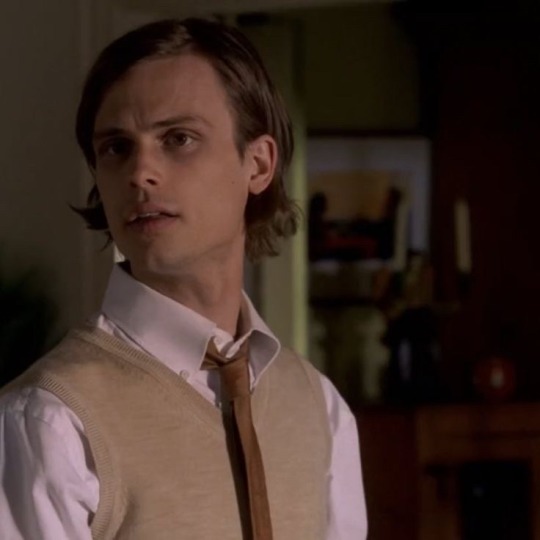

and colorful cardigans and neck accessories


and cute browline glasses
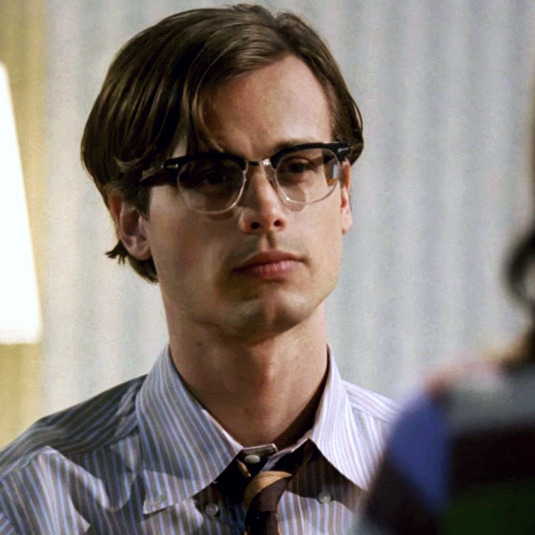

and loves Doctor Who

and has a little bit of a dark side


and- oh.
It would seem Luke Alvez and I share a Type.
#criminal minds#spencer reid#penelope garcia#the writers/producers/costume department would not take notice of this#which is both annoying/absolutely baffling bc it's Right There & fucking hilarious#like LOOK AT THEM
815 notes
·
View notes
Photo







THE WRITE STUFF (#126, JUL 2011)
Star Wars: The Clone Wars head writer Christian Taylor took the show to epic heights with Season Three’s intriguing Mortis trilogy. The veteran writer on Lost and Six Feet Under shares his thoughts on where the show is headed in Season Four! Interview by Jonathan Wilkins
You came to the The Clone Wars after great success with Lost and Six Feet Under. What are the advantages in writing an animated series over live action?
The thing that is so exciting about this show is that what we can do is mind-blowing. In TV, you’ll often find yourself trying to do something that gets compromised or cut because of schedule or budget. We keep the budget down on The Clone Wars as well, but what the animators do is so incredible that if you can imagine it and write it, they can make it happen. We had a writers’ room for the third season and George Lucas was in there with us. He’s very keen to push the boundaries of the show. We were all drama writers who had worked in live action, so they took us around the animation department and we saw the artists hard at work on sets and characters. It’s like a huge movie.
Sometimes in the writers’ room when we were pitching ideas I noticed the producer, Cary Silver, putting his head in his hands, thinking Uh oh, that’s gonna’ be expensive! But Dave Filoni [supervising director] just chuckled!
Are there any disadvantages to working in animation?
There are certain technical things that just can’t be done. For instance, we can’t change a costume on a character. That would be easier in live action. The costume is actually integrated into the character, so you’ll see characters in the same costume for a long time. Water and fabric are very hard to do on a TV animation schedule, because it’s all about how long it takes to render something.
You have to take into account how long it’s going to take to make the show. The Mortis story arc that I wrote three years ago was broadcast only a few months ago. I’ve just handed scripts in for episodes that might air who knows when!
Does your background in drama mean the drama in the show will intensify?
The thing with all television shows is that they take a bit of time to find their feet. That’s their nature, and a lot of TV shows don’t get the time to do that. George is so behind this show, that he’s allowed it to grow. I think the show is told from Ahsoka’s point of view. As she matures, I think the show matures. There was definitely a shift when they brought on more drama writers. I don’t really view it any differently than telling an episode of Lost; it’s just that we get to do it with this incredible animation.
The tone changed in the middle of Season Three, and I think there’ll be more of that as the show continues because the stories are becoming more epic in scope. We’re being allowed to tell stories in three- and four-episode arcs that are like mini-movies. We don’t have to cram everything into 22 minutes; it’s like having a three-act structure.
Were you a Star Wars fan as a kid?
I saw the first film at the seminal age of 8 or 9.1 grew up watching those first three movies to the point where I was building these huge sets. I had this tiny bedroom, and I designed a table that would lower from the ceiling on a rope. I built the sets with polystyrene, and I would get all the plants from the garden to make Dagobah, for example. I got a heating element and put it in a “bog” so that it would bubble and get misty. Yes, I was a fan!
Is the Expanded Universe an influence on your work?
I never really accessed the Star Wars Expanded Universe, and that keeps me focused on The Clone Wars. I think that some writers can feel bogged down by the EU. A lot of it isn’t vital to telling stories in The Clone Wars. The films are very important to me, but I try to approach the show from a character and story perspective. I work with great people who know all about the Expanded Universe, so it can be referenced if need be. One of the great things about The Clone Wars is that if George Lucas says it’s true, then it’s true. That’s not to diminish the storytellers of the Expanded Universe, but we get the privilege to sit with George and hear him explain in detail what the rules of the Force are, and what the rules of the Jedi Order are.
What sort of things did he go into?
We were talking about the Mortis arc. George spoke about the Force for about 20 minutes. It was a really specific, carefully thought-out, spiritually aligned philosophy. Everybody in the room was hushed.
Afterwards Dave said, “George hasn’t really talked about the Force a lot in the context of the show, so it’s really exciting that he’s getting to do this.” That was one of the reasons why I chose to do this trilogy of episodes that featured the Force so prominently.
Did you have any idea that you'd were be writing for Liam Neeson, who reprised the role of Qui-Gon Jinn for the Mortis episodes?
I didn’t even think about it. When that happened it was fantastic. It just gives that arc weight and I think for fans it was really fun. I love Liam Neeson he’s fantastic, cool, and a dude!
When we see Qui-Gon, is he a Force spirit?
I think it may be a little unfair of me to givea definitive answer. I think the Force is incredibly powerful and the ability to manifest after death is something that only a few Jedi can do. We can’t be definitive because it is Mortis and nothing on Mortis can be trusted or believed.
Would you like the chance to write more for the older Ahsoka?
Yes, there are some very interesting things that we are going to do with her. The show started with her, and I think it will end with her story. We’re trying to write to that. We’re very much writing in chronological order now. We’re not jumping back and forth in time anymore.
Anakin’s fight against the dark side is something we keep seeing hints of in the show. How far can you take that?
We pushed it pretty far with Mortis, and there will definitely be other things to look out for as we build towards Revenge of the Sith. The challenging thing about this show is that it’s in a specific timeline, so we can’t deviate from that timeline. That can be frustrating, but it also keeps us precise in our storytelling. I think the Mortis trilogy was a chance to really go at it, and there will be other emotional arcs as the story builds. There will be some interesting events that occur, although I can’t say what they are yet!
I just handed in a story, featuring a certain character, and I can’t say who the character is, but it’s epic, mind-blowing stuff that came from George. Unfortunately, you’re not going to see it until sometime in the future!
Are there any characters that you'd like to have the chance to write for that haven't appeared yet?
I don’t know, I’m trying to think who we haven’t done yet.
I think it would be great to do Han Solo, but I defer to Dave and George on that. You don’t want the show to get so cutesy that every character who’s in the show was in the movies. I think that Chewbacca and Tarkin are in the body of that world, but Han Solo doesn’t relate to anybody, so I’m not sure.
47 notes
·
View notes
Text
Diversmagazin Interview Translation
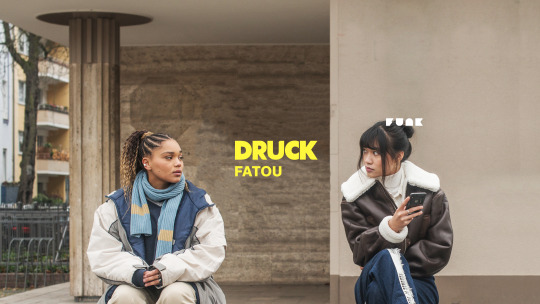
Diversmagazin released an interview with director Sarah Blaßkiewitz and Head-Writer Jasmina Wesolowski today. Read it here in German.
Jasmina (she/her), DRUCK writer since season four and head writer since season six together with Jonas Lindt. In a writers Room with Paulina Lorenz and Raquel Kishori Dukpa (Jünglinge)
Sarah (she/her) director of the last four episodes from season six
I’m leaving out the general introductory questions.
Alicia: Can you talk about the writing process? And what’s the most important thing for you while writing and telling stories?
Jasmina: We especially wanted the profound exchange with young adults who represent our protagonists. For season six we had the challenge that we wanted to tell the lovestory of a Gambian-German girl and a Vietnamese-German girl, perspectives that aren’t represented in the writer’s room. That’s why we talked a lot to research partners, to make up for our lack of knowledge/ experience, but we also talked to the actors and actresses.
Alicia: Why do different directors work on DRUCK?
Sarah: We try to produce as much in real-time as possible. And of course, we have to pre-produce but still have to work [overlappingly]. While one director is already in the editing phase, the next one already starts to shoot. Another reason is of course, that this way, also in the writer’s room, there’s more space for diversity.
Alicia: It’s similar to the writer’s room. You’re also dividing the writing of scenes between different people. … Are you working together with racism and LGBTQIA+ experts?
Jasmina: I think we all have blind spots and that it’s absolutely impossible to end up with a perfect result. It was an important first step, that the Jünglinge collective joined. They are big advocates for queer BIPoc representation in German media. They were always present for feedback loops and made all of us, crew, actors and actresses, participate in an anti-racism workshop. We were lucky to have the brilliant author and anti-racism trainer Arpana Berndt, who advised us on these topics. On top of that, we did a lot of research on different topics. I think now it should be the only way to produce movies and shows this way, with an intensive research phase. This way you don’t appropriate the stories of others and also don’t tell inauthentic stories or, in the worst case, use hurtful clichés/stereotypes. It was helpful and needed that Black perspectives were present also behind the camera – Sara as a director, but also in the social media team, make-up department or costume design. But we are also aware that more can be done.
Sarah: It’s important to me to highlight the make-up and costume design department. When I, an afro-German person, joined this project and met other afro-German women in those departments, who can relate to me, the character of Fatou and Ava, I was really glad. I can say from many years of experience that that’s not a given.
Alicia: How about experts on LGBTQIA+ issues?
Jasmina: To talk a bit about the process: We were set on Fatou being a lesbian pretty early on, and that was already discussed in the earlier writer’s room, where that perspective wasn’t present yet. In the beginning, those were loose ideas, and we had to implement them with the casting. The casting team Raquel Kishori Dupka, Melek Yaparak and Angelika Buschina worked closely with the directors and contacted different institutions and specifically asked for actors and actresses who could be queer. At this age this is of course a super sensitive topic. You don’t want to force young people to [define themselves/come out]. It’s a huge challenge to handle that with care and it was extremely important that the Jünglinge collective was part of the casting process.
But also, apart from the casting process, we profited a lot from the queer people in the writer’s room in the cast.
Sarah: For my part I asked the authors and queer people “What would you like? What is nice? What hurts? What’s important? Or what have I never seen before?” And then I put those different experiences into the different scenes. On top you of course need common sense (?) to portray something that you haven’t experienced yourself.
Jasmin: I just thought of a small really beautiful example: How Fatou was given these rainbow socks as a Christmas present. You immediately notice, that was the idea of a queer person who knows what non-queer parents give to their kids as gifts. The fans notice: Queer people were in the writer’s room. Or “Ah, these actresses know, what they’re doing.“ And those are the small things that make a difference.
Alicia: For sure! In DRUCK you notice that queer people were part of this in really subtle ways, and that [resulted] in really nice fan-moments. I can confirm that.
Right now, the community is discussing the conflict between Mailin and Ava a lot. What role does that conflict play for you and what does it teach us?
Sarah: I’m editing the last episodes right now, so I really feel it, also because you already see the reactions online.
For me, the conflict is important because it shows over a long period of time, that not everything is always only good or only bad. That it takes a lot of time, patience and confrontation to understand all nuances of that kind of conflict.
That Ava could be prevented to outright say what’s bothering her, because we’re talking about a really serious trauma of exclusion. How do you even tell people really personal stuff when you were bullied for years? And now we have that conflict, that seemingly takes forever, and you’re always asking yourself: “Why aren’t they talking to each other?” But it’s only in real time that you realize how hurtful this conflict is. How hurtful it is what they experience. What racism means, and also what it means to [deal] with that topic as a white German girl. And I think it’s really important that everyone is going through that with this season. That takes time and sometimes hurts. And you don’t always understand Ava and you don’t always understand Mailin. When we really [dedicate ourselves to understand this conflict] then I think, we can experience what for example a person like me experienced their whole adolescence. I’m not saying I was bullied my whole adolescence, and maybe it wasn’t because of the color of my skin, but because of something else. But that went on for half a year. After being bullied in school for half a year you’re not up for school and your classmates anymore. And you don’t talk to them anymore. And if people realize that because of this season then I’m glad. I think it’s really touching that this conflict takes up so much space.
Jasmina: I found it really interesting what you said about the nuances, because it was a real process for me to learn how many facets this conflict has. And especially that us white people, who grow up in a society with structural racism, have a particular idea about what racism means. And that’s not a detailed and uncritical perspective of that topic: As soon as you call me racist, I feel attacked and start defending myself.
The role that this conflict played for us was to show how incredibly exhausting it is as a Person of Color, to always have to deal with these problems and that there’s a kind of fatigue, that you don’t want to talk (or should want to talk) about certain topics anymore, especially if you have other things going on in your life on top of it.
On the other hand, we have Mailin, who has a strong desire to understand. She’s not aware of her privileges as a white girl. We want to take this journey together, when she starts to realize things and when she goes through different stages; until she understands, what it is really about. We also have an arc there that isn’t finished. Because in real life, you have to deal with some topics over and over again. We think it’s especially important to show that it’s not the job of Black people to explain racism to their white friends. By now, they have all the resources to educate themselves and to talk with other white people about this topic, to unburden Black people.
Alicia: That’s really interesting! The lovestory of Kieu My and Fatou is an important part of season six, which many queer young adults love. How is the relationship between Fatou and Kieu My representative for a generation?
Sarah: I can actually also see it in an older generation. When I send the cuddle clip of Kieu My and Fatou to my grandpa, he says “Wow, how amazing that a Viet-German and a Afro-German girl are lying in bed together, talk in German and are in a relationship.” This generation hopefully isn’t alone anymore, for example in the sense of: being the only Afro-German person in a small city. That changed and now we see it in that second and third generation. And that’s why it shows me something very real and beautiful.
Alicia: Which scene are you really proud of and why?
Sarah: My favorite scene, and one I’m really proud of and that was really important concerning the pressure of school, was with the main character Fatou. It’s about a path of finding yourself from Fatou and a [Reinigungsmoment] with her brother. Two people, who know each other from the moment of their birth, are sitting together. When I read that scene I thought yes, I can relate, I can feel that, and when we shot that, a world opened for me. And that was partly because of the music, which was decided before we shot this scene. Then we shot it and it was fucking cold, but we shot it again and again but every time we really felt it like the first time. And when I now watch that scene while editing, it really is the perfect moment. Every facial expression is perfect, every reaction. And that’s that kind of truthful (?) moment you’re looking for as an actor, actress, director or author. When everything fits.
(There’s a script for every social media part, What’s App Chats and ideas for social media stories. )
Alicia: When can we expect the next season and what will it be about?
Jasmina: For now, DRUCK is finished and we have to wait how it will continue. Fingers are crossed and of course we’re hoping for a new season.
[Note by me: We‘re not gonna spiral, Jünglinge looked for more writers, Black writers, on facebook a while ago. Nothing is safe but they probably don’t want to make any promises]
#druck#I hope it's understandabl vghghv#It was really cool to hear their thoughts on the mailin ava conflict and bullying storyline
157 notes
·
View notes
Text
Call the Midwife Trixie (BBC)
New Post has been published on https://walrusvideo.com/call-the-midwife-trixie-bbc/
Call the Midwife Trixie (BBC)
When it comes to “Call the Midwife’s” Trixie, there’s something unique in the way the British drama does it. It can make us feel so warm and fuzzy inside with its characters’ familiar maternal presence, but at the same time leave us gutted by the harsh realities of London’s East End in the 1960s. Who wouldn’t want to have a baby delivered by the bubbly blonde nurse Trixie Franklin (Helen George)? She heralds her still-in-pin-curls arrival—to both a birth and a new season—by chirping, “magic-carpet midwifery services at your disposal!” but by the end of the episode, not even Trixie’s happy engagement news to her curate boyfriend Tom Hereward (Jack Ashton) can scrub away the agony we’ve just witnessed over the past hour.
On This Page
Trixie from Call The Midwife
Trixie Franklin – Helen George
Trixie – Helen George
MORE ON CALL THE MIDWIFE
Trixie from Call The Midwife
Helen George (born Helen Thomas; 19 June 1984) is the English actress who plays Trixie Franklin on the BBC TV drama series Call the Midwife. She is a highly successful and much-loved actress. In 2015, she participated in the thirteenth series of BBC One’s Strictly Come Dancing; she was paired with Aljaz Skorjanec and finished in sixth place.
Think that call the midwife is all vintage costumes, chubby-cheeked babies and jolly post-wartime sing-alongs? Think again. Ever since the first episode aired in 2012, the writers have made a point of featuring dark and deeply upsetting storylines – including the thalidomide scandal of the 1960s, female genital mutilation, domestic violence, rape, illegal abortions, contraception and homophobia. Through it all there has been Trixie…
Trixie Franklin – Helen George
On September 10, 2020, Helen George settled back into her “trailer” lifestyle after she shared a glamourous photo from her camper van on the set of call the midwife. However, the actress was forced to shut down any suggestion that her character nurse Trixie Franklin is due to tie the knot in the new series.
Birmingham-born actor Helen George, 35, is best known as nurse Trixie Franklin in BBC 1’s hit drama “Call the midwife”. She is currently playing the title role in the Theatre Royal Bath’s touring production of Daphne du Maurier’s my cousin Rachel.
A “Call the midwife” has responded to online trolls who have criticised her weight gain in the latest series of the show. Helen George, who plays nurse Trixie Franklin, filmed series seven while pregnant, and so has a fuller face and body than in previous shows. The 33-year-old gave birth last October to a healthy baby girl, named Wren Ivy, who she had with her partner and co-star Jack Ashton. He plays Rev Tom Hereward in the show.
BBC One – Call the Midwife – Trixie Franklin
“Call the midwife” viewers were left bereft on Sunday (11 February) night, as Trixie Franklin departed as part of her alcoholism storyline. Viewers first saw Trixie, played by Helen George, speak up about her alcohol addiction back in 2015, when she sought help from the samaritans and began attending alcoholics anonymous meetings.
Call the Midwife: how they disguised pregnant Helen George’s baby bump
BBC drama “Call the midwife” returned to PBS, and if you’re a fan, we’ve got some exciting news for you. Helen George, who plays the role of Trixie Franklin, has some real-life baby news of her own in this series. Is Helen George pregnant?
Good news “Call the midwife” fans! The powers that be have gifted us with a few teases as to what Season 10 of this heartwarming show has in store. Let’s just say we’re on the edge of our seats. Taking to Instagram yesterday, the call the midwife account shared a stunning photo of our beloved Helen George who plays Trixie Franklin, the bright and glamorous nurse with an outgoing disposition on the show.
The Call the Midwife stars who you didn’t realise are a couple in real-life
In season 7 of “Call the Midwife”, as we return to Nonatus house for season 7 of call the midwife, it is the bone-chilling winter of 1963, and we are on the cusp of the swinging ’60s that London defined. If the Beatles aren’t in the air already, they soon will be, and it’s just a year before Michael Apted’s groundbreaking documentary series begins running on British telly.
Call the midwife season 7, episode 5. Christopher (Jack Hawkins) drives nurse Trixie Franklin (Helen George) to the airport. When will she return? Trixie tries to quietly exit stage left, tiptoeing out of Nonnatus House at dawn as everyone is asleep. She finds Christopher waiting outside, a surprise taxi to take her to the airport. Hang on though, we assumed she was going to a treatment facility, but she mentions Portofino and her Godmother.
Helen George stuns in a beautiful close-up photo taken by beau Jack Ashton
The “Call the midwife” season 6 Christmas special in 2016 was the one where Sister Winifred (Victoria Yeates), Sister Julienne (Jenny Agutter), Dr Patrick Turner (Stephen McGann), Nurse Trixie Franklin (Helen George), nurse Phyllis Crane (Linda Bassett) and nurse Barbara Gilbert (Charlotte Ritchie) go to work at hope clinic mission hospital in South Africa. No need for their trademark red cardigans there!
Helen George brings a decade of beauty, wit and growth to one of UK TV’s most iconic female characters,” they gushed in the caption. Going on to discuss all the wonderful elements which Trixie and Helen encompass. They continue, “Helen, and her peerless portrayal of Trixie from Series 1 has been an essential part of the glue that binds our community of Nonnatus House”.
Trixie – Helen George
After a tumultuous year, call the midwife is finally returning this Christmas with their annual holiday special. And while the show will be packed with beloved characters like Judy Parfitt as Sister Monica Joan, Helen George as Trixie, and laura main’s Shelagh, fans may notice one conspicuous absence from the lineup. After four seasons on the show, Jennifer Kirby who plays nurse Valerie Dyer has announced her departure from call the midwife.
While producers of call the midwife were able to, thankfully, ‘deliver’ the Annual Christmas special just in time for Christmas day 2020, the full season of the drama did not arrive in time for its usual January slot this year thanks to covid-19 and a five-month production delay. But, there seems to be light at the end of the poplar tunnel….
Call the Midwife shares first picture from Series 10 – and teases exciting Trixie Franklin plotline
“Call the midwife”s” nurse Trixie will still be struggling with alcoholism and series seven will feature “painful” storylines for the popular character. Helen George’s character, who has been on the hit BBC period drama since series 1, is currently in a happy relationship with dentist Christopher (Jack Hawkins).
Call the Midwife casts Leonie Elliott as new West Indian Midwife
Well, it’s likely to be the same line-up as the Christmas special. That featured. Jenny Agutter (Sister Julienne), Linda Bassett (nurse Crane), Judy Parfitt (Sister Monica Joan), Fenella Woolgar (sister Hilda), Ella Bruccoleri (sister Frances), Helen George (Trixie), Laura Main (Shelagh Turner), Leonie Elliott (Lucille), Stephen McGann (Dr Turner), Cliff Parisi (Fred), Annabelle Apsion (Violet), Georgie Glen (Miss Higgins), Max Macmillan (Timothy), Daniel Laurie (Reggie) and Zephyr Taitte (Cyril).
Call the Midwife season ten: everything we know so far
Helen George has become a fixture in the Christmas viewing schedule for the last eight years, stepping into the role of the glamorous midwife Trixie in “Call the midwife”. The series spanning the 50s and 60s is the heartwarmer we all need this Christmas. Helen George doesn’t just reserve the glamour for her on-screen character. The actor regularly shares images of her own stunning home that she shares with partner Jack Ashton and daughter Wren.
Call the Midwife shares new sneak-peek at series 10
“Call the midwife” star Helen George has unveiled a stunning new hair transformation. The 25-year-old actress is best known for playing Nurse Trixie Franklin in the beloved medical drama. She is also known for her bright blonde locks, but now the mum-of-one has gone and transformed her look with a new shorter cut.
I was so sad when Reverend Tom and Trixie ended their engagement and Barbara Gilbert starting dating Tom. Tom and Barbara didn’t seem a likely match. I really hated the scene when they are dancing to “ teach me tiger” by April Stevens. Zero sparks there. With Tom and Trixie, this scene would have been sizzling. The actors that played tom ( Jack Aston ) and Trixie ( Helen George) were really involved in 2016 and had a baby together although not engaged or married.
Characters from Call the Midwife
“Call the Midwife Trixie” (BBC) Holiday Special 2020 cast: Sister Monica Joan (Judy Parfitt), sister Julienne (Jenny Agutter), May Turner (April Rae Hoang), nurse Lucille Anderson (Leonie Elliott), Trixie (Helen George), Angela Turner (Alice Brown), nurse Phyllis Crane (Linda Bassett). It is in December 1965. Everyone at Nonnatus house is looking forward to traditional celebrations with all the trimmings, but nothing goes quite to plan.
All of your favourites will be back for the Christmas special.
More on “Call the Midwife”
“Are we going to close after all?” Nurse Trixie asked but she was assured Nonnatus house would be safe. Sister Julienne divulged: “No. We are going to expand. Early next year I will be revealing further details”.
Characters from Call the Midwife
Helen was pregnant during the filming of series 7 of call the midwife. Her character nurse Trixie Franklin made an emotional exit from the show after Helen’s baby bump began to show and couldn’t be hidden. To create a plausible exit for her, nurse Trixie was seen seeking help after spiralling back into alcoholism.
Resume
Helen George was born on June 19, 1984, in Birmingham, West Midlands, England as Helen Elizabeth George. She is an actress, known for the three musketeers (2011), call the midwife (2012) and the monster (2015). She was previously married to Oliver Boot.
Nurse Trixie has been the life and soul of Nonnatus house since the very first episode of call the midwife in 2012. Trixie loves nothing more than to gossip with her fellow nuns and nurses and enjoys poking her nose into other people’s business.
Helen George stars as nurse Trixie Franklin
Between biking around poplar, working late nights, and dealing with lots of crying babies (and mothers), the midwives of Nonnatus House don’t often get the chance to dazzle with their hair and makeup, but for the real-life actresses who play them, walking the red carpet is just another day in the life. In preparation for the show’s upcoming ninth season, here’s a look at what the characters call the midwife really look like.
The entire episode of call the midwife has me broken. Trixie deserves better honestly she’s just so selfless and it makes me so emotional.
All about Call the Midwife
Set in the 1950s and 60s in the East End of London, “Call the Midwife” is a period drama television series that centres around a group of midwives and nuns of Nonnatus house. They are trying to do the best they can for the community, given the medical issues and lack of facilities. Created by Heidi Thomas, the show first released in the UK on January 15, 2012, on BBC !.
Call the midwife sadly will not be back on TV screens in December 2020 as the filming of the new episodes was pushed back due to the pandemic. The BBC has confirmed the official date when Series 10 will return, however fans have been treated to a behind-the-scenes image of one iconic character.
Where is Trixie on “Call the Midwife” Season 7? We can understand the episode picking up tonight and there are many out there who are asking said question almost immediately. So, where is she? It’s a pretty simple question with a fairly simple answer: Trixie is off getting some time away from Nonnatus, presumably to recover from her recent struggles with alcohol abuse. She allowed her addiction to get the best of her and, as a result of that, put herself in a position where she could harm some other people with her habits.
“Call the Midwife” fans were in tears after Sunday night’s finale (23 February), which featured a devastating death and a powerful moment for Trixie Franklin. The season 9 finale was hailed for its sensitive handling of Ann Mitchell’s character Elsie Dyer battling against Oesophagus cancer while being cared for by her distraught niece, Jennifer Kirby’s nurse Valerie.
One of the things that we’ve come to learn with call the midwife over time is that effectively, nobody is spared from a medical emergency. That includes Shelagh and Dr Turner’s au pair Magda, who found herself at the centre of some controversy over an illness. For more “Call the Midwife” article-talk we think that you will enjoy a visit to the Totally Pregnant website here: Totalypregnant.com
The Article Call the Midwife Trixie (BBC) First Appeared ON : https://gqcentral.co.uk
#gallery-1 margin: auto; #gallery-1 .gallery-item float: left; margin-top: 10px; text-align: center; width: 33%; #gallery-1 img border: 2px solid #cfcfcf; #gallery-1 .gallery-caption margin-left: 0; /* see gallery_shortcode() in wp-includes/media.php */
Go to Source Author: Steve
2 notes
·
View notes
Text
Bryan Caselli: The Frederator Interview
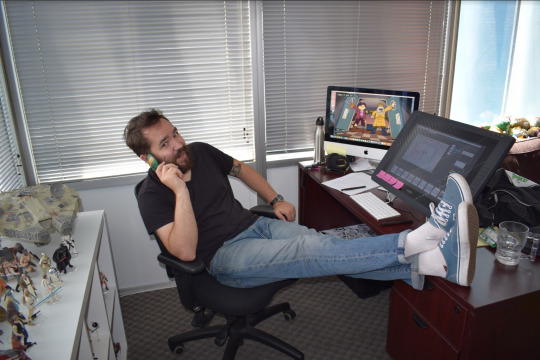
Bryan Caselli is a Storyboard Artist, Writer and Renaissance Faire enthusiast. Following tenure on top-notch cartoons including Star vs. the Forces of Evil and Sanjay and Craig, ‘twas our good fortune when he set sail to Costume Quest as co-Executive Producer, with a treasure trove of story skillz in tow. Here, Bryan provides his advice to young artists, fav things about Costume Quest, and remarkably realistic take on a 17th century Swashbuckler and his Mer-Lassy.
When did you know that you wanted a career in animation?
My friends and family were alway super supportive of my drawing when I was little, but I got really focused on art in high school. I had an amazing teacher named Kevin McGovern who encouraged me to apply to the California State Summer School for the Arts. CSSSA was a four week residency arts summer program on CalArts’ campus featuring many different disciplines. I studied in the animation department, and it was like I finally found my people. After those four weeks, I knew I wanted to work in animation, and I wanted to go to school at CalArts. There was no turning back.
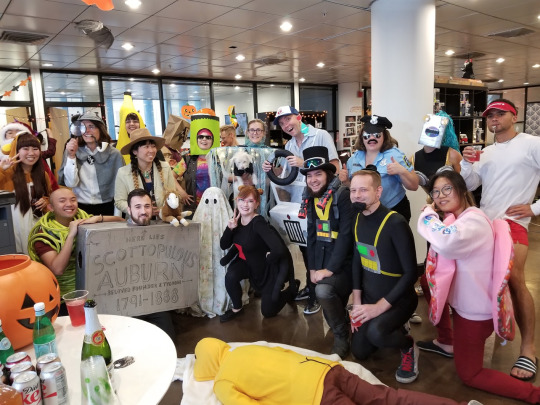
(Every day is Halloween for the CQ crew! But this day was actually Halloween.)
Where are you from, and how did you chart your path to CalArts?
I'm originally from Sacramento, California. It's a legitimately sized city, but it still has a small town vibe that's warm and welcoming. I applied to CalArts straight out of high school, but didn't get in on my first try. I actually didn't apply to any other schools. My plan was to just apply again the next year, but my mom secretly applied for me to CSU Sacramento as a somewhat, "What if he doesn't get into CalArts for ten years?" worst case scenario backup plan. After swallowing the tough pill of not getting into my dream school, I took a collection of figure drawing, portrait drawing, painting, and art history classes at both Sac State and Sac City college. I didn't stay long enough to earn a degree. Luckily, I was accepted into CalArts the following year.
How did you decide you wanted to storyboard and write?
I got into animation thinking I wanted to be a character designer. It seemed to be the most glamorous position at the time, but I found out quickly that you have to be an exceptional draftsman to do that job, which I'm not. I fell in love with the story department in my 3rd and 4th years at CalArts. I had some awesome teachers who really set me on the path that I'm on now.
What do you love most about the job?
I can't get enough of stuff like mythic structure, archetypal symbolism, and fable storytelling. I really get excited by just how universal storytelling is. It can connect you with anyone. That's easily my favorite part of my work.
What was your first job in animation or art, and how’d you land it?
I interned on Regular Show. I actually went in to interview for a different show, but on my way out, I ran into Ben Adams, the Regular Show character designer and my former classmate. He told me to blow those other guys off and come work with him. He introduced me to Regular Show's Producer, Janet Dimon, and we really hit it off. She offered me the position soon after that. At the end of my internship, I pitched the storyboards for my student film, Scout Wars. After the pitch, someone from development came up to me and said, "You need to pitch this upstairs." That's how I got my second gig.
youtube
The show was never produced, but getting paid to develop my original concept that early in my career really set in stone my desire to run a show of my own some day. I even got to work with our future Costume Quest Art Director, Ricky Cometa, on the development poster. After that, I did about a year and a half of full-time freelance, which eventually lead me to work with the creators of Sanjay and Craig on some of their punk side projects. I really liked working with those guys, so when they asked me to come on Sanjay, it was an easy choice.

That’s awesome. Was Sanjay the first show you wrote and boarded for? How is it to work on a board driven show?
Yep, Sanjay was the first TV show that I got to write and storyboard on. Both writing and storyboarding is really demanding, but it's also really rewarding. Nick Bachman (Costume Quest's previously interviewed Supervising Producer) was my Storyboard Director on Sanjay, and we really clicked as a team. Sanjay and Craig was a perfect show to be board driven because it was super cartoony and there were very few rules. It was a great opportunity for board teams to have their specific voices heard. When you watch an episode of Sanjay and Craig you can pretty much spot which teams did which episodes from a mile away.
How was writing on Star vs the Forces of Evil - is it board driven too?
Writing on Star was an awesome change of pace coming off of Sanjay. Daron Nefcy was a great leader to work for, and I became really close with my fellow writers. It was board driven, which made the transition from storyboarding to outline writing a lot more of a doable task for me. I was comfortable in that kind of production pipeline and pretty much knew what would be expected of me as a writer. The coolest part about working on Star was that it was a seasonally arcing, somewhat mythic story. It was so cool to get to craft a large story over multiple episodes. I took a lot of lessons learned writing on Star and brought them with me to the writers' room on Costume Quest.
Is it odd being a bit of a ~star~ yourself, considering you have a whole fan page and everything?!
Oh boy, having a fan wiki page is a strange feeling. It's really cool to be apart of a show that has such a passionate fanbase, but honestly I don't want to be a star. Star Butterfly is the star of Star.
You’re Costume Quest’s co-Executive Producer. What does the job entail?
Being the co-EP on Costume Quest means I, along with the rest of our leadership team, am responsible to supervise just about every stage of production. From writing to storyboarding, animatics to art, voice acting and voice casting, logo design, score, sound effects, the list goes on and on. I got to script a handful of episodes. Nick and I storyboarded the first episode. Occasionally I do some (very rough) first pass character designs. I also draw story board punch-ups and animation redline revisions on the episodes I direct. I direct the first story of each of Costume Quest's two part episodes, and Nick directs the second story. Beyond that I mainly keep my eye on the larger narrative of the show, making sure everything is tonally consistent and the story threads line up. If every person that works on this show is making one tree, I try to make sure the forest is working as a whole. I do my best not to force any artist to execute their assignments exactly as I would have, but instead, encourage them to showcase their personal artistic voices.
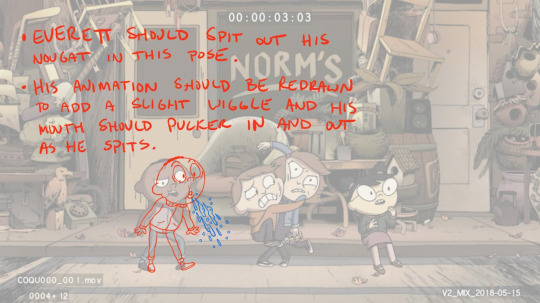
How have you enjoyed working on Costume Quest, and what do you like most about the show?
Working on Costume Quest has been my favorite gig yet. I am really grateful to Will (McRobb), Kevin (Kolde), and Eric (Homan) for bringing me onboard. I'm super proud of how much the show grows across the first season. The scale, the emotional stakes, and the world building just get bigger and bigger with every episode. Beyond that, having the chance to lead a team has been incredibly rewarding. Our whole crew is so talented, and they are all so supportive of the show. It has really meant a lot to me to learn that these people, who I respect tremendously, are happy to come in to work every day and are proud to help tell this story. I can't overstate how good it feels to know I have a creatively and professionally satisfied crew.
Do you have a favorite character on CQ?
I love all four of the main kids, but my favorite character really is Norm. I always say that he's a cross between Fred Flintstone and Santa Clause. He's such an emotionally vulnerable character, and he's got some great reveals attached to his backstory. Fred Tatasciore also does some incredible voice acting as Norm, so if this show only gets one award ever, it should go to Fred's performance.
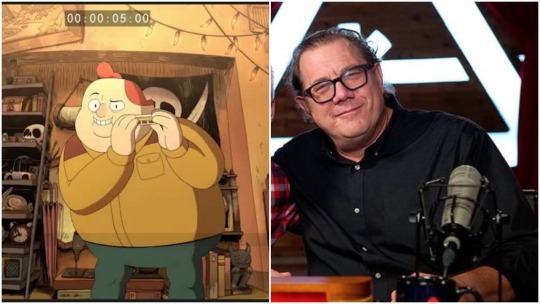
Since developing Scout Wars, have you gone out pitching other original ideas?
I’ve pitched Scout Wars and a handful of other show ideas around to the big studios, but when Costume Quest came about, I knew it was the perfect opportunity to learn everything I needed to about the responsibilities of a show runner—without the added emotional pressure of having the show be about my childhood, or my relationship with my father, or whatever. I have a handful of ideas in my back pocket that I'm eager to start pitching again whenever Costume Quest comes to a close.
What are your favorite cartoons?
Not including the shows I've worked on: original Teenage Mutant Ninja Turtles, Batman the Animated Series, Justice League/Justice League Unlimited, Doug, Hey Arnold!, SpongeBob, Simpsons, Bob's Burgers, Archer, Flintstones, the Peanuts specials, and the original Power Rangers gets a non-cartoon honorable mention because the the influence that show had on me and Costume Quest is pretty undeniable.
What is your advice to people who want to write and/or storyboard for animation?
Study the craft as hard as you can. It's not about networking, or Internet likes, or whatever. If you get as good as you possibly can at the craft, you'll be golden. Take any job that will hire you. Once you get any position anywhere, if you show everyone you work with just how dedicated you are, people will take notice, and they'll want to help you.
What do you enjoy doing outside of work?
I really love hosting backyard BBQ's and parties at my place. My friends tease me that I'd rather they come to me than I go anywhere else pretty much 100% of the time. You can find me most Sunday mornings at any of the LA flea markets with my girlfriend, Madison, looking for more knick knacks to put up in our place. Also, I take my Renaissance Faire costuming pretty seriously. Yearly upgrades are planned months in advance. My mom always sewed my Halloween costumes growing up, so costumes somehow became a thing I really like to do. I guess it's fitting that Costume Quest came my way.
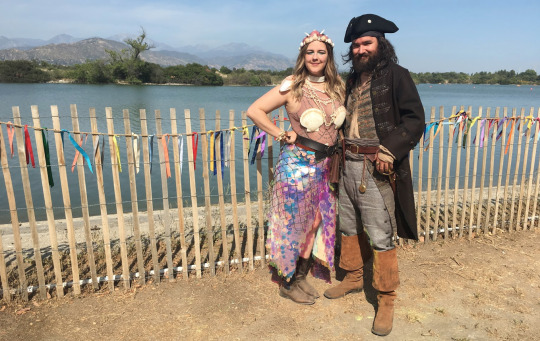
Have anything to say to future fans of Costume Quest?
Watch it again! We did our best to set up, pay off, and foreshadow as much as possible in the season so it would be fun to rewatch. There are a lot of little easter eggs in there. I hope fans enjoy it. ☆
No doubt, they will. Thank you for the interview Bryan, and for your fantastic work on Costume Quest! Follow Bryan on Instagram.
- Cooper ☆
#The Frederator Interview#costume quest#star vs#star vs the forces of evil#sanjay and craig#frederator#cartoon#nickelodeon#disney#animation#writer#producer#interview#artist#new cartoon#costume#cosplay
31 notes
·
View notes
Text
Love is in the Air Chapter 6
Jared Padalecki x Reader
1300 Words
Story Summary:Jared is a Flight Attendant, one of the best in the country. Y/N is one of the hottest Hollywood stars. Both intensely attracted to each other, but prejudices get in the way. Can Jared get past his idea of how Y/N should be? Can Y/N show Jared that she’s not the normal actress, but one who is shy and down to Earth, giving them a chance at love?
Catch Up Here: Masterpost

Your good mood stayed the entire cab drive as you made your way to the studio. You were so glad things were better between you and Jared, and you hoped that dinner with him would go well. You really liked him. He was kind, and handsome, and he didn’t seem to like you because you were a famous actress. It seemed like all your recent boyfriends had been interested in your social status more than who you really were. It had been that fact that made you weary to new relationships, wanting something real. And that seemed like it could happen with Jared.
Stepping out of the cab, you walked into the busy studio, waving at the secretary who buzzed you right in. Taking a deep breath, you stepped into the main office, which bustled with life. You could see the writers in their own little conference room, going over the final script, their fingers covered in ink as they crossed out words and argued over what was better.
Across from them was your favorite department, the costume department. This movie would have amazing dresses and outfits, and you couldn’t wait to see them. Towards the back was where the producer, director and anyone else in charge of the movie kept their offices, and that’s where you made your way.
This movie was unique in the fact that everything was happening in one building, but that’s what had made you interested in it to begin with. Everything about this movie seemed to draw you in, and even if it bombed in the theaters, you hoped that it would be something you could be proud of.
“There’s our girl!” Andy, the producer of the show exclaimed, coming forward to air kiss your cheeks, holding on to your shoulders. “Even prettier than I remembered!”
“Hi Andy,” you smiled up at him, the smile quickly disappearing when you saw Tony in the main conference room, winking when he noticed you staring at him. “Andy, how long does Tony have to stay?”
“Oh, that’s right! He said the two of you flew in together,” Andy muttered, running his hand along his beard. “He says you’re totally into him.”
You felt comfortable enough with Andy that you knew you could tell him anything, and it would go no farther. “I think he’s into me. But Andy, he’s kind of threatened me, blackmailed me into a date with him. Is there something you can do?”
Sighing, Andy frowned. “Y/N, he’s our main sponsor. If we make him mad, this whole picture could go down in the drain.”
“But Andy, he can’t treat me like this!” You argued, just as the conference door opened, and Tony, along with Simon, the director.
“There she is!” Tony exclaimed, pulling you into a hug. Feeling awkward and uncomfortable, you stood there stiffly until he pulled away and Simon shook your hand.
“You are right. She is the perfect Abigail,” he stated, looking you up and down. But his look didn’t feel predatory, like Tony’s did.
“She’s absolutely stunning,” Tony agreed.
“Come on Y/N, we have some drawings of the costumes we want to show you,” Simon insisted, pulling you into the conference room, with Tony and Andy following behind.
The rest of your day was spent in that conference room, going over the script, the costumes, adding any ideas as they problem solved. It felt good, to have your voice be heard, to be a part of the process and not just the actress who followed her queues.
You hated how Tony’s gaze seemed to follow your every movement. There were times he would come to stand beside you, his hand resting on your lower back as you glanced over something, making your skin crawl. You wanted nothing more than to slap his hand away, to kick him out of the office, but you couldn’t. Andy had seemed to make that clear.
So when Andy and Simon left, leaving you alone with Tony, you tried to stay on your side of the table, as far away from him as possible. As you peered down in amazement at the costume design, you noticed the room darkening, and you glanced up to see him lowering the blinds, locking the door.
“Tony, what are you doing?” You asked him, but he just smiled your way, continuing on his mission to lower all the blinds. “I’m going to go get a cup of coffee,” you muttered heading to the door, but before you could reach it, he reached out, grasping your arm, halting your movement.
“I don’t think so,” he insisted. “This is our first chance alone together, and I’ve been wanting to do this all day.”
Pushing you until your back was flat against the wall, he trapped you with one hand above your head. Licking his lip, he leaned down, pressing his slimy wet lips to yours as you struggled to get away. “Tony, stop!” You exclaimed, fighting harder when you felt his hand on your waist, moving up your skin, dangerously close to your bra. “No!” You screamed, getting enough strength to push him away.
Breathing heavily, you raced across the room, throwing open the door, running into a startled Andy and Simon. Pointing back to Tony, you stared at them with wide eyes. “Get rid of him, now!” You insisted, drawing the attention of the entire office.
“Now Y/N, whatever happened, we can deal with this. Just calm down, and we’ll talk.”
“No,” you spat. “I don't need to calm down. That man can’t keep his hands to himself, and I want him removed from this office!”
“I don’t know what she’s talking about,” Tony argued, coming out of the conference room, staring down at you with a wicked glint in his eyes. “She threw herself at me. Probably after me for my money, but who was I to say no to a nice piece of ass.”
“That’s not true!” You argued, your voice rising. “This man has pushed himself on me, not once but twice. He’s degrading, and has been nothing but rude to me. If you don’t remove him, then..”
“Then what?” Tony prodded? “You remove me, and this movie won’t get made. No money, no movie. Make your choice.”
Heartbroken that it was coming to this, you felt a tear slip down your cheek. “Andy, please,” you pleaded with your friend, who stared at you with guilt in his eyes. “You know I wouldn’t lie.”
“I know Y/N, but we need his money,” he answered, sealing your fate.
“I was looking forward to working on this movie,” you told them. “But I can’t work in an office that allows a man to harass the women in here. It’s not right, and I wish I had proof so I could have this guy thrown in jail where he belongs.”
“Y/N, what are you saying?” Simon asked, his arms crossed as he stared cooly your way.
“Looks like you’re going to need to hire another actress. Because I won’t stay here. I can’t, and risk the chance that this asshole can’t keep it in his pants. So, I quit,” you muttered, before shoving past them and walking out the door.
It wasn’t until you were back in the sunshine, waiting for another cab to rescue you, that what just happened dawned on you. With tears streaming down your cheeks, you slid into the cab, giving them the address of your friends house.
It was hard, knowing that you had done the right thing. You had given up your dream role, but you couldn’t stay there. Not with that man who wouldn’t take no for an answer.
Sam/Jared Tags:@a-girl-who-loves-disney @barbedwireandbubblegum @imagine-inc @kay18115 @musicalsarelove @lenaabs @lovesamwinchester @mereka18 @sadmac356 @shadowhunter7 @shawnsassymendes-main @sireennotsiren @sizzlingbearpolice @sortaathief
Love is in the Air Tags:@deansgirl215 @eleven-eleven-make-your-wish @i-is-for-inspiring @iamnotsaneatall @imascio08 @is-that-a-gas-leak-or-a-demon @jordannicole56 @kay18115 @lizmalfoywayland @luciferslucille @phoenixia67 @pjofangirl18 @shaelyn102 @shamelesslydean @tiffanycaruso @that-really-awkward-dinosaur @troubletrumble
Forever Tags: @16wiishes @4401lnc @amanda-teaches @andreaaalove @angelsandwinchesters @artisticpoet @atc74 @be-amaziing @bemyqueenofdarkness @bohowitch @brooke-supernatural16 @brunettechick @camelotandastronauts @captainradicalpassion @chelsea072498 @clairese1980 @captainemwinchester @createdbybadappreciation @darthdeziewok @destiels-new-girl @donnaintx @dont-you-dare-say-misha @dslocum89 @duckieburns @docharleythegeekqueen @emmazach @emilicious-7 @emoryhemsworth @ericaprice2008 @essie1876 @generalgoldfishldrm @goldenolaf25 @growningupgeek @hms-fangirl @imboredsueme @internationalmusicteacher @ithinkimadorable-67 @iwriteaboutdean @jayankles @jbbarnesgirl @jensen-gal @just-another-busy-fangirl @karlee-fay-my-wayward-son @keelzy2 @li-ssu @littleblue5mcdork @lowlyapprentice @luciferslucille @mellowlandrunaway @mogaruke @my-squirrel-and-moose @nanie5 @newtospnfandom @oneshoeshort @percussiongirl2017 @pilaxia @pizzarollpatrol @plaid-lover-bay25 @rosegoldquintis @roxyspearing @samanddeanmyheroes @sandlee44 @shamelesslydean @sillesworldofwriting @sgarrett49 @skyewardolicitycloisdelena91 @spnbaby-67 @spn-dean-and-sam-winchester @spnwoman @sunskittlex @superbadassnatural @tardis-full-of-fallen-angels @teamfreewill92 @thebikiniinspector @thing-you-do-with-that-thing @tmccarney @totallovelesson @tunadean @vvinch3st3r @wildlandfox @winchesterbrothers-inc @winchesterxtwo @winchester-writes @worldwidehansum @zombiewerewolfqueen
#love is in the air#jared padalecki x reader#jared padalecki au#'supernatural x reader#supernatural au#supernatural reader insert#supernatural rpf#katy writes#supernatural fanfiction#jared padalecki fanfiction#supernatural series
168 notes
·
View notes
Text
News reports & helpful information on POS & POS Equipment.
A St. Vincent album drop is as much about the latest costume that Annie Clark is trying on as it is about the music. With her past two releases, as she gained an increasingly large following, she transformed into (by her own account) a near-future cult leader (for 2014’s St. Vincent) and a dominatrix at a mental institution (for 2017’s Masseduction). It’s not just a promotional shtick. Even if the particulars of what it means to inhabit these creative personae are fuzzy, they all work as part of a greater oeuvre, carrying through themes visually, sonically, and even in her live performances. On her Masseduction tour, Clark had an unwavering commitment to latex bodycon suits, and a faceless guitar tech meekly brought her guitars out, all but laying them at her feet.
For the release of her sixth studio album, Daddy’s Home, the Dallas-reared musician instead embraced a moment in time: the seventies. Early singles garnered comparisons to the original musical chameleon, David Bowie, and a slew of other artists prolific in the early and middle part of the decade. The album cover revealed her slouching in a fuzzy coat, slip dress, thigh-high stockings, and a cropped blond wig. Promotional videos and images nailed the intended aesthetic: Clark told Rolling Stone in February that she was inspired by “the color palette of the world of Taxi Driver” and “Gena Rowlands in a Cassavetes film.”
The resulting album is a lush audio buffet and a sharp departure from the art-pop Clark has honed in her past two LPs. Lead single “Pay Your Way in Pain” mostly closely resembles the dystopian dreamscape heard on Masseduction, if hit with club drugs and viewed in black and white. But much of the rest of the album is noticeably more demure. “Live in the Dream,” a six-and-a-half-minute Pink Floyd–inspired journey, trips along with blooming melodies and glittery guitar that finally snaps into blistering focus. (If there were any way for the musical reference to be missed, she begins the song with an unmistakable “Hello,” nodding to “Comfortably Numb,” and the next song references the “dark side of the moon.”) The smooth bass line of “Down and Out Downtown” opens up into surreal layers of sound, coasting over a hazy New York after a night out at the bars.
Clark and producer Jack Antonoff clearly had fun with Daddy’s Home. There is sitar (a lot of sitar), there are mellophones, and there is a Greek chorus of backup singers, including Donny Hathaway’s daughter Kenya. There are musical references and inspirations you could argue about for days. It’s an anachronistic joy.
After mental institution dominatrix, the seventies in New York—the city where Clark now splits her time when not with family in Dallas—should have been easy enough to convey, as a broad inspiration rather than an album-specific identity. And judging by the festival success of bands like Greta Van Fleet, who, despite their protestations about the comparison, often sound like a carbon copy of Led Zeppelin, plenty of listeners are here to embrace nostalgia.
And yet, among the entire St. Vincent discography, the rollout of Daddy’s Home seems to be the most confusing for both fans and critics to parse.
That’s largely because of another component of the buildup to the album’s May 14 release: Clark’s father was released from prison in 2019, after serving ten years for his involvement in a multimillion-dollar penny-stock manipulation scheme. And now that, well, Daddy’s home, this song collection mines the seventies albums they listened to together when she visited him in Oklahoma, where he moved after his divorce from Clark’s mother.
Clark, often famously bored and frustrated with the press, has made sure to underscore that she never wanted to share the story of her father’s incarceration, which first publicly surfaced in a 2017 New Yorker profile. When writer Nick Paumgarten asked if she felt shame about her father’s crimes, she said, “Shame? Not at all. I didn’t do anything wrong. It’s not my shame.” Daddy’s Home was her attempt to lean into this family trauma on her own terms. She needed a way to, as she told NPR, tell her own story with “humor and compassion and not the kind of salaciousness” you might find in a “tabloid story.”
Early reviews and interviews have focused on the tiny autobiographical glimpses Clark gave us, often trying to shoehorn the album into a neatly packaged family story. And when that fails, critics have fallen all over themselves talking about the album’s retro pastiche��which, to be fair, is prominent, as if we’re plunked on a shag carpet, flipping through her dad’s vinyl collection. But the artists she drew from, including Steely Dan, Pink Floyd, and, hell, even Bowie, arguably never had to answer for themselves in the tell-all way that we expect Clark to.
If the men named by critics and the musician herself have been the noted musical influences for the album, women are the lyrical inspiration. These songs are full of odes to female artists and creators who “were maligned for being brave and speaking out,” Clark told Bustle. Joni Mitchell, Nina Simone, Marilyn Monroe, and Tori Amos all make appearances in “The Melting of the Sun,” a dinner party of tough women set to a warbly ooze of Wulitzers and sitar. (“Saint Joni ain’t no phony / Smoking Reds where Furry sang the blues / My Marilyn shot her heroin / ‘Hell’, she said, ‘It’s better than abuse.’ ”) A shout-out to long-departed Warhol superstar Candy Darling, a transgender actress and Velvet Underground muse, brings the album to a close, a wistful, key-driven offering to the woman Clark deems the “queen of South Queens”: “Candy, darling, I brought bodega roses for your feet.”

Zackery Michael
Darling and Monroe epitomize the glamour we bestow upon women who die young, who weren’t here long enough to take control of their own narrative. They are remembered largely for their beauty and ability to embody the desire projected onto them by others. Mitchell, Simone, and Amos, on the other hand, enjoyed (or continue to enjoy) long lives and robust careers. They’re part of a canon of songwriters that Clark almost surely hopes she will be able to join.
But Clark, at present, seems to fear landing in the gulf between these two groups—unable or unwilling to tell her own story as she wants it told, and fearing that her work alone won’t be enough to speak for itself.
That anxiety would explain the tension in Daddy’s Home. Despite the album’s title, the lyrics are only vaguely personal; listeners will find meaning in them only if they already know the story, one Clark has been asked about countless times on her current press junket. And she fills that distance between wanting to claim her own story and wanting privacy with wall-to-wall seventies nostalgia to the point of distraction at times. That’s perhaps by design, but it’s still jarring. Clark’s commitment to world-building brings the otherwise lovely slow turn “The Laughing Man”—brushed with steel guitars, brimming with ethereal guitar work—to a grinding halt with a line: in a tender moment of reflection with a childhood friend, Clark sings of “half-pipes and PlayStations.” It’s an uncomfortable jolt into the present.
But the greatest moments of Daddy’s Home come when she forgets the theme almost entirely. Even then, those moments are centered on the cultural norms that we expect of women. In the chunky, lyrical slow-build of “My Baby Wants a Baby,” punctuated by more of the slick production but this time with more cherry-picking, the narrator explores her own guilt about not being fully onboard with a partner who’s ready to settle down and start a family. She frets that her child might inherit her eyes and her mistakes, about how the responsibilities of parenthood could fundamentally alter her focus: “But I wanna play guitar all day / Make all my meals in microwaves / Only dress up if I get paid / How can it be wrong?”
For most men, being great is enough to merit whatever distance their genius requires. We’ve celebrated and valorized famously reclusive or prickly men, reminding ourselves that tolerating their egos and their mistakes is all part of the process. For years, Clark has railed against the idea that female songwriters must be confessional, and her own mechanisms for avoiding that have been clear. Whether Clark returns to her more developed caricatures on future albums remains to be seen. But she’s given us a peek behind the mask, even if it’s at a distance. In a different world, she wouldn’t have to.
This post was published here.
We trust that you found the article above of help or of interest. You can find similar content on our blog: www.easttxpointofsale.com Please let me have your feedback in the comments section below. Let us know which subjects we should write about for you next.
youtube
#Point of Sale#clover Pos Reviews#lightspeed Pos Reviews#lightspeed Restaurant#lightspeed Support#point of sale#shopkeep Hardware#shopkeep Pricing#shopkeep Support#touchbistro Cloud#touchbistro Pricing
0 notes
Text
News reports & helpful information on POS & POS Equipment.
A St. Vincent album drop is as much about the latest costume that Annie Clark is trying on as it is about the music. With her past two releases, as she gained an increasingly large following, she transformed into (by her own account) a near-future cult leader (for 2014’s St. Vincent) and a dominatrix at a mental institution (for 2017’s Masseduction). It’s not just a promotional shtick. Even if the particulars of what it means to inhabit these creative personae are fuzzy, they all work as part of a greater oeuvre, carrying through themes visually, sonically, and even in her live performances. On her Masseduction tour, Clark had an unwavering commitment to latex bodycon suits, and a faceless guitar tech meekly brought her guitars out, all but laying them at her feet.
For the release of her sixth studio album, Daddy’s Home, the Dallas-reared musician instead embraced a moment in time: the seventies. Early singles garnered comparisons to the original musical chameleon, David Bowie, and a slew of other artists prolific in the early and middle part of the decade. The album cover revealed her slouching in a fuzzy coat, slip dress, thigh-high stockings, and a cropped blond wig. Promotional videos and images nailed the intended aesthetic: Clark told Rolling Stone in February that she was inspired by “the color palette of the world of Taxi Driver” and “Gena Rowlands in a Cassavetes film.”
The resulting album is a lush audio buffet and a sharp departure from the art-pop Clark has honed in her past two LPs. Lead single “Pay Your Way in Pain” mostly closely resembles the dystopian dreamscape heard on Masseduction, if hit with club drugs and viewed in black and white. But much of the rest of the album is noticeably more demure. “Live in the Dream,” a six-and-a-half-minute Pink Floyd–inspired journey, trips along with blooming melodies and glittery guitar that finally snaps into blistering focus. (If there were any way for the musical reference to be missed, she begins the song with an unmistakable “Hello,” nodding to “Comfortably Numb,” and the next song references the “dark side of the moon.”) The smooth bass line of “Down and Out Downtown” opens up into surreal layers of sound, coasting over a hazy New York after a night out at the bars.
Clark and producer Jack Antonoff clearly had fun with Daddy’s Home. There is sitar (a lot of sitar), there are mellophones, and there is a Greek chorus of backup singers, including Donny Hathaway’s daughter Kenya. There are musical references and inspirations you could argue about for days. It’s an anachronistic joy.
After mental institution dominatrix, the seventies in New York—the city where Clark now splits her time when not with family in Dallas—should have been easy enough to convey, as a broad inspiration rather than an album-specific identity. And judging by the festival success of bands like Greta Van Fleet, who, despite their protestations about the comparison, often sound like a carbon copy of Led Zeppelin, plenty of listeners are here to embrace nostalgia.
And yet, among the entire St. Vincent discography, the rollout of Daddy’s Home seems to be the most confusing for both fans and critics to parse.
That’s largely because of another component of the buildup to the album’s May 14 release: Clark’s father was released from prison in 2019, after serving ten years for his involvement in a multimillion-dollar penny-stock manipulation scheme. And now that, well, Daddy’s home, this song collection mines the seventies albums they listened to together when she visited him in Oklahoma, where he moved after his divorce from Clark’s mother.
Clark, often famously bored and frustrated with the press, has made sure to underscore that she never wanted to share the story of her father’s incarceration, which first publicly surfaced in a 2017 New Yorker profile. When writer Nick Paumgarten asked if she felt shame about her father’s crimes, she said, “Shame? Not at all. I didn’t do anything wrong. It’s not my shame.” Daddy’s Home was her attempt to lean into this family trauma on her own terms. She needed a way to, as she told NPR, tell her own story with “humor and compassion and not the kind of salaciousness” you might find in a “tabloid story.”
Early reviews and interviews have focused on the tiny autobiographical glimpses Clark gave us, often trying to shoehorn the album into a neatly packaged family story. And when that fails, critics have fallen all over themselves talking about the album’s retro pastiche—which, to be fair, is prominent, as if we’re plunked on a shag carpet, flipping through her dad’s vinyl collection. But the artists she drew from, including Steely Dan, Pink Floyd, and, hell, even Bowie, arguably never had to answer for themselves in the tell-all way that we expect Clark to.
If the men named by critics and the musician herself have been the noted musical influences for the album, women are the lyrical inspiration. These songs are full of odes to female artists and creators who “were maligned for being brave and speaking out,” Clark told Bustle. Joni Mitchell, Nina Simone, Marilyn Monroe, and Tori Amos all make appearances in “The Melting of the Sun,” a dinner party of tough women set to a warbly ooze of Wulitzers and sitar. (“Saint Joni ain’t no phony / Smoking Reds where Furry sang the blues / My Marilyn shot her heroin / ‘Hell’, she said, ‘It’s better than abuse.’ ”) A shout-out to long-departed Warhol superstar Candy Darling, a transgender actress and Velvet Underground muse, brings the album to a close, a wistful, key-driven offering to the woman Clark deems the “queen of South Queens”: “Candy, darling, I brought bodega roses for your feet.”

Zackery Michael
Darling and Monroe epitomize the glamour we bestow upon women who die young, who weren’t here long enough to take control of their own narrative. They are remembered largely for their beauty and ability to embody the desire projected onto them by others. Mitchell, Simone, and Amos, on the other hand, enjoyed (or continue to enjoy) long lives and robust careers. They’re part of a canon of songwriters that Clark almost surely hopes she will be able to join.
But Clark, at present, seems to fear landing in the gulf between these two groups—unable or unwilling to tell her own story as she wants it told, and fearing that her work alone won’t be enough to speak for itself.
That anxiety would explain the tension in Daddy’s Home. Despite the album’s title, the lyrics are only vaguely personal; listeners will find meaning in them only if they already know the story, one Clark has been asked about countless times on her current press junket. And she fills that distance between wanting to claim her own story and wanting privacy with wall-to-wall seventies nostalgia to the point of distraction at times. That’s perhaps by design, but it’s still jarring. Clark’s commitment to world-building brings the otherwise lovely slow turn “The Laughing Man”—brushed with steel guitars, brimming with ethereal guitar work—to a grinding halt with a line: in a tender moment of reflection with a childhood friend, Clark sings of “half-pipes and PlayStations.” It’s an uncomfortable jolt into the present.
But the greatest moments of Daddy’s Home come when she forgets the theme almost entirely. Even then, those moments are centered on the cultural norms that we expect of women. In the chunky, lyrical slow-build of “My Baby Wants a Baby,” punctuated by more of the slick production but this time with more cherry-picking, the narrator explores her own guilt about not being fully onboard with a partner who’s ready to settle down and start a family. She frets that her child might inherit her eyes and her mistakes, about how the responsibilities of parenthood could fundamentally alter her focus: “But I wanna play guitar all day / Make all my meals in microwaves / Only dress up if I get paid / How can it be wrong?”
For most men, being great is enough to merit whatever distance their genius requires. We’ve celebrated and valorized famously reclusive or prickly men, reminding ourselves that tolerating their egos and their mistakes is all part of the process. For years, Clark has railed against the idea that female songwriters must be confessional, and her own mechanisms for avoiding that have been clear. Whether Clark returns to her more developed caricatures on future albums remains to be seen. But she’s given us a peek behind the mask, even if it’s at a distance. In a different world, she wouldn’t have to.
This post was published here.
We trust that you found the article above of help or of interest. You can find similar content on our blog: www.easttxpointofsale.com Please let me have your feedback in the comments section below. Let us know which subjects we should write about for you next.
youtube
#Point of Sale#clover Pos Reviews#lightspeed Pos Reviews#lightspeed Restaurant#lightspeed Support#point of sale#shopkeep Hardware#shopkeep Pricing#shopkeep Support#touchbistro Cloud#touchbistro Pricing
0 notes
Text
News reports & helpful information on POS & POS Equipment.
A St. Vincent album drop is as much about the latest costume that Annie Clark is trying on as it is about the music. With her past two releases, as she gained an increasingly large following, she transformed into (by her own account) a near-future cult leader (for 2014’s St. Vincent) and a dominatrix at a mental institution (for 2017’s Masseduction). It’s not just a promotional shtick. Even if the particulars of what it means to inhabit these creative personae are fuzzy, they all work as part of a greater oeuvre, carrying through themes visually, sonically, and even in her live performances. On her Masseduction tour, Clark had an unwavering commitment to latex bodycon suits, and a faceless guitar tech meekly brought her guitars out, all but laying them at her feet.
For the release of her sixth studio album, Daddy’s Home, the Dallas-reared musician instead embraced a moment in time: the seventies. Early singles garnered comparisons to the original musical chameleon, David Bowie, and a slew of other artists prolific in the early and middle part of the decade. The album cover revealed her slouching in a fuzzy coat, slip dress, thigh-high stockings, and a cropped blond wig. Promotional videos and images nailed the intended aesthetic: Clark told Rolling Stone in February that she was inspired by “the color palette of the world of Taxi Driver” and “Gena Rowlands in a Cassavetes film.”
The resulting album is a lush audio buffet and a sharp departure from the art-pop Clark has honed in her past two LPs. Lead single “Pay Your Way in Pain” mostly closely resembles the dystopian dreamscape heard on Masseduction, if hit with club drugs and viewed in black and white. But much of the rest of the album is noticeably more demure. “Live in the Dream,” a six-and-a-half-minute Pink Floyd–inspired journey, trips along with blooming melodies and glittery guitar that finally snaps into blistering focus. (If there were any way for the musical reference to be missed, she begins the song with an unmistakable “Hello,” nodding to “Comfortably Numb,” and the next song references the “dark side of the moon.”) The smooth bass line of “Down and Out Downtown” opens up into surreal layers of sound, coasting over a hazy New York after a night out at the bars.
Clark and producer Jack Antonoff clearly had fun with Daddy’s Home. There is sitar (a lot of sitar), there are mellophones, and there is a Greek chorus of backup singers, including Donny Hathaway’s daughter Kenya. There are musical references and inspirations you could argue about for days. It’s an anachronistic joy.
After mental institution dominatrix, the seventies in New York—the city where Clark now splits her time when not with family in Dallas—should have been easy enough to convey, as a broad inspiration rather than an album-specific identity. And judging by the festival success of bands like Greta Van Fleet, who, despite their protestations about the comparison, often sound like a carbon copy of Led Zeppelin, plenty of listeners are here to embrace nostalgia.
And yet, among the entire St. Vincent discography, the rollout of Daddy’s Home seems to be the most confusing for both fans and critics to parse.
That’s largely because of another component of the buildup to the album’s May 14 release: Clark’s father was released from prison in 2019, after serving ten years for his involvement in a multimillion-dollar penny-stock manipulation scheme. And now that, well, Daddy’s home, this song collection mines the seventies albums they listened to together when she visited him in Oklahoma, where he moved after his divorce from Clark’s mother.
Clark, often famously bored and frustrated with the press, has made sure to underscore that she never wanted to share the story of her father’s incarceration, which first publicly surfaced in a 2017 New Yorker profile. When writer Nick Paumgarten asked if she felt shame about her father’s crimes, she said, “Shame? Not at all. I didn’t do anything wrong. It’s not my shame.” Daddy’s Home was her attempt to lean into this family trauma on her own terms. She needed a way to, as she told NPR, tell her own story with “humor and compassion and not the kind of salaciousness” you might find in a “tabloid story.”
Early reviews and interviews have focused on the tiny autobiographical glimpses Clark gave us, often trying to shoehorn the album into a neatly packaged family story. And when that fails, critics have fallen all over themselves talking about the album’s retro pastiche—which, to be fair, is prominent, as if we’re plunked on a shag carpet, flipping through her dad’s vinyl collection. But the artists she drew from, including Steely Dan, Pink Floyd, and, hell, even Bowie, arguably never had to answer for themselves in the tell-all way that we expect Clark to.
If the men named by critics and the musician herself have been the noted musical influences for the album, women are the lyrical inspiration. These songs are full of odes to female artists and creators who “were maligned for being brave and speaking out,” Clark told Bustle. Joni Mitchell, Nina Simone, Marilyn Monroe, and Tori Amos all make appearances in “The Melting of the Sun,” a dinner party of tough women set to a warbly ooze of Wulitzers and sitar. (“Saint Joni ain’t no phony / Smoking Reds where Furry sang the blues / My Marilyn shot her heroin / ‘Hell’, she said, ‘It’s better than abuse.’ ”) A shout-out to long-departed Warhol superstar Candy Darling, a transgender actress and Velvet Underground muse, brings the album to a close, a wistful, key-driven offering to the woman Clark deems the “queen of South Queens”: “Candy, darling, I brought bodega roses for your feet.”

Zackery Michael
Darling and Monroe epitomize the glamour we bestow upon women who die young, who weren’t here long enough to take control of their own narrative. They are remembered largely for their beauty and ability to embody the desire projected onto them by others. Mitchell, Simone, and Amos, on the other hand, enjoyed (or continue to enjoy) long lives and robust careers. They’re part of a canon of songwriters that Clark almost surely hopes she will be able to join.
But Clark, at present, seems to fear landing in the gulf between these two groups—unable or unwilling to tell her own story as she wants it told, and fearing that her work alone won’t be enough to speak for itself.
That anxiety would explain the tension in Daddy’s Home. Despite the album’s title, the lyrics are only vaguely personal; listeners will find meaning in them only if they already know the story, one Clark has been asked about countless times on her current press junket. And she fills that distance between wanting to claim her own story and wanting privacy with wall-to-wall seventies nostalgia to the point of distraction at times. That’s perhaps by design, but it’s still jarring. Clark’s commitment to world-building brings the otherwise lovely slow turn “The Laughing Man”—brushed with steel guitars, brimming with ethereal guitar work—to a grinding halt with a line: in a tender moment of reflection with a childhood friend, Clark sings of “half-pipes and PlayStations.” It’s an uncomfortable jolt into the present.
But the greatest moments of Daddy’s Home come when she forgets the theme almost entirely. Even then, those moments are centered on the cultural norms that we expect of women. In the chunky, lyrical slow-build of “My Baby Wants a Baby,” punctuated by more of the slick production but this time with more cherry-picking, the narrator explores her own guilt about not being fully onboard with a partner who’s ready to settle down and start a family. She frets that her child might inherit her eyes and her mistakes, about how the responsibilities of parenthood could fundamentally alter her focus: “But I wanna play guitar all day / Make all my meals in microwaves / Only dress up if I get paid / How can it be wrong?”
For most men, being great is enough to merit whatever distance their genius requires. We’ve celebrated and valorized famously reclusive or prickly men, reminding ourselves that tolerating their egos and their mistakes is all part of the process. For years, Clark has railed against the idea that female songwriters must be confessional, and her own mechanisms for avoiding that have been clear. Whether Clark returns to her more developed caricatures on future albums remains to be seen. But she’s given us a peek behind the mask, even if it’s at a distance. In a different world, she wouldn’t have to.
This post was published here.
We trust that you found the article above of help or of interest. You can find similar content on our blog: www.easttxpointofsale.com Please let me have your feedback in the comments section below. Let us know which subjects we should write about for you next.
youtube
#Point of Sale#clover Pos Reviews#lightspeed Pos Reviews#lightspeed Restaurant#lightspeed Support#point of sale#shopkeep Hardware#shopkeep Pricing#shopkeep Support#touchbistro Cloud#touchbistro Pricing
0 notes
Text
News reports & helpful information on POS & POS Equipment.
A St. Vincent album drop is as much about the latest costume that Annie Clark is trying on as it is about the music. With her past two releases, as she gained an increasingly large following, she transformed into (by her own account) a near-future cult leader (for 2014’s St. Vincent) and a dominatrix at a mental institution (for 2017’s Masseduction). It’s not just a promotional shtick. Even if the particulars of what it means to inhabit these creative personae are fuzzy, they all work as part of a greater oeuvre, carrying through themes visually, sonically, and even in her live performances. On her Masseduction tour, Clark had an unwavering commitment to latex bodycon suits, and a faceless guitar tech meekly brought her guitars out, all but laying them at her feet.
For the release of her sixth studio album, Daddy’s Home, the Dallas-reared musician instead embraced a moment in time: the seventies. Early singles garnered comparisons to the original musical chameleon, David Bowie, and a slew of other artists prolific in the early and middle part of the decade. The album cover revealed her slouching in a fuzzy coat, slip dress, thigh-high stockings, and a cropped blond wig. Promotional videos and images nailed the intended aesthetic: Clark told Rolling Stone in February that she was inspired by “the color palette of the world of Taxi Driver” and “Gena Rowlands in a Cassavetes film.”
The resulting album is a lush audio buffet and a sharp departure from the art-pop Clark has honed in her past two LPs. Lead single “Pay Your Way in Pain” mostly closely resembles the dystopian dreamscape heard on Masseduction, if hit with club drugs and viewed in black and white. But much of the rest of the album is noticeably more demure. “Live in the Dream,” a six-and-a-half-minute Pink Floyd–inspired journey, trips along with blooming melodies and glittery guitar that finally snaps into blistering focus. (If there were any way for the musical reference to be missed, she begins the song with an unmistakable “Hello,” nodding to “Comfortably Numb,” and the next song references the “dark side of the moon.”) The smooth bass line of “Down and Out Downtown” opens up into surreal layers of sound, coasting over a hazy New York after a night out at the bars.
Clark and producer Jack Antonoff clearly had fun with Daddy’s Home. There is sitar (a lot of sitar), there are mellophones, and there is a Greek chorus of backup singers, including Donny Hathaway’s daughter Kenya. There are musical references and inspirations you could argue about for days. It’s an anachronistic joy.
After mental institution dominatrix, the seventies in New York—the city where Clark now splits her time when not with family in Dallas—should have been easy enough to convey, as a broad inspiration rather than an album-specific identity. And judging by the festival success of bands like Greta Van Fleet, who, despite their protestations about the comparison, often sound like a carbon copy of Led Zeppelin, plenty of listeners are here to embrace nostalgia.
And yet, among the entire St. Vincent discography, the rollout of Daddy’s Home seems to be the most confusing for both fans and critics to parse.
That’s largely because of another component of the buildup to the album’s May 14 release: Clark’s father was released from prison in 2019, after serving ten years for his involvement in a multimillion-dollar penny-stock manipulation scheme. And now that, well, Daddy’s home, this song collection mines the seventies albums they listened to together when she visited him in Oklahoma, where he moved after his divorce from Clark’s mother.
Clark, often famously bored and frustrated with the press, has made sure to underscore that she never wanted to share the story of her father’s incarceration, which first publicly surfaced in a 2017 New Yorker profile. When writer Nick Paumgarten asked if she felt shame about her father’s crimes, she said, “Shame? Not at all. I didn’t do anything wrong. It’s not my shame.” Daddy’s Home was her attempt to lean into this family trauma on her own terms. She needed a way to, as she told NPR, tell her own story with “humor and compassion and not the kind of salaciousness” you might find in a “tabloid story.”
Early reviews and interviews have focused on the tiny autobiographical glimpses Clark gave us, often trying to shoehorn the album into a neatly packaged family story. And when that fails, critics have fallen all over themselves talking about the album’s retro pastiche—which, to be fair, is prominent, as if we’re plunked on a shag carpet, flipping through her dad’s vinyl collection. But the artists she drew from, including Steely Dan, Pink Floyd, and, hell, even Bowie, arguably never had to answer for themselves in the tell-all way that we expect Clark to.
If the men named by critics and the musician herself have been the noted musical influences for the album, women are the lyrical inspiration. These songs are full of odes to female artists and creators who “were maligned for being brave and speaking out,” Clark told Bustle. Joni Mitchell, Nina Simone, Marilyn Monroe, and Tori Amos all make appearances in “The Melting of the Sun,” a dinner party of tough women set to a warbly ooze of Wulitzers and sitar. (“Saint Joni ain’t no phony / Smoking Reds where Furry sang the blues / My Marilyn shot her heroin / ‘Hell’, she said, ‘It’s better than abuse.’ ”) A shout-out to long-departed Warhol superstar Candy Darling, a transgender actress and Velvet Underground muse, brings the album to a close, a wistful, key-driven offering to the woman Clark deems the “queen of South Queens”: “Candy, darling, I brought bodega roses for your feet.”

Zackery Michael
Darling and Monroe epitomize the glamour we bestow upon women who die young, who weren’t here long enough to take control of their own narrative. They are remembered largely for their beauty and ability to embody the desire projected onto them by others. Mitchell, Simone, and Amos, on the other hand, enjoyed (or continue to enjoy) long lives and robust careers. They’re part of a canon of songwriters that Clark almost surely hopes she will be able to join.
But Clark, at present, seems to fear landing in the gulf between these two groups—unable or unwilling to tell her own story as she wants it told, and fearing that her work alone won’t be enough to speak for itself.
That anxiety would explain the tension in Daddy’s Home. Despite the album’s title, the lyrics are only vaguely personal; listeners will find meaning in them only if they already know the story, one Clark has been asked about countless times on her current press junket. And she fills that distance between wanting to claim her own story and wanting privacy with wall-to-wall seventies nostalgia to the point of distraction at times. That’s perhaps by design, but it’s still jarring. Clark’s commitment to world-building brings the otherwise lovely slow turn “The Laughing Man”—brushed with steel guitars, brimming with ethereal guitar work—to a grinding halt with a line: in a tender moment of reflection with a childhood friend, Clark sings of “half-pipes and PlayStations.” It’s an uncomfortable jolt into the present.
But the greatest moments of Daddy’s Home come when she forgets the theme almost entirely. Even then, those moments are centered on the cultural norms that we expect of women. In the chunky, lyrical slow-build of “My Baby Wants a Baby,” punctuated by more of the slick production but this time with more cherry-picking, the narrator explores her own guilt about not being fully onboard with a partner who’s ready to settle down and start a family. She frets that her child might inherit her eyes and her mistakes, about how the responsibilities of parenthood could fundamentally alter her focus: “But I wanna play guitar all day / Make all my meals in microwaves / Only dress up if I get paid / How can it be wrong?”
For most men, being great is enough to merit whatever distance their genius requires. We’ve celebrated and valorized famously reclusive or prickly men, reminding ourselves that tolerating their egos and their mistakes is all part of the process. For years, Clark has railed against the idea that female songwriters must be confessional, and her own mechanisms for avoiding that have been clear. Whether Clark returns to her more developed caricatures on future albums remains to be seen. But she’s given us a peek behind the mask, even if it’s at a distance. In a different world, she wouldn’t have to.
This post was published here.
We trust that you found the article above of help or of interest. You can find similar content on our blog: www.easttxpointofsale.com Please let me have your feedback in the comments section below. Let us know which subjects we should write about for you next.
youtube
#Point of Sale#clover Pos Reviews#lightspeed Pos Reviews#lightspeed Restaurant#lightspeed Support#point of sale#shopkeep Hardware#shopkeep Pricing#shopkeep Support#touchbistro Cloud#touchbistro Pricing
0 notes
Text
fic: Yoda, Yuletide, and You
Title: Yoda, Yuletide, and You
Author: @drosophilase
Gifted to: @djchika as part of the @crisscolfergiftexchange 2017
Original prompt: “We made the mutual decision to go to this party separately and when I arrived there was this asshole flirting with you and I’m trying not to make it obvious that I’m seething with jealousy but it’s really difficult”
Ratings/Warning: Teen; allusions to sex (non-explicit), boss/employee relationship
Read on AO3!
Sorry this is two days late, thank you for the gracious extension and Merry Christmas Deej! Thank you so much for all you did to arrange this exchange <3
--
It had started, as most great love stories do, with a Yoda figurine on the corner of Chris's desk. "That green figurine, I like," croaked a terrible Yoda impersonation from the twenty-fifth (ok, just fifth) person Chris had interviewed that day. Darren Criss, his application said.
Chris raised an eyebrow. Giving interviews for a job at a nerd pop culture online news source, Chris thought he had heard it all. This guy is the first to be bold enough to do such a confident and terrible impersonation. Chris touches Yoda's pointy ear. "From my sister. She's determined to get me the entire Star Wars Funko Pop set over the next 20 Christmases and birthdays." He doesn't comment aloud on the terrible Yoda voice, but he does write a little Y in the corner of Darren's resume.
"That's so cool, man, it's awesome that your family knows what you love. I have a ton of Pops but I can't ever seem to finish a set. There's just too many other things I like. I just put my Chewie next to my Harley Quinn and go with it." There's a sort of sparkle in his eye, glowing gold in the sunlight filtering through Chris's office blinds.
Chris sets the resume aside (he'd already noted this one for the qualifications - degree in Theatre from Michigan University, four years on the Michigan Daily staff with one as senior editor. Proficiency in Final Cut and a few credits in web series and local theatre productions. Currently working in local news media and writing a blog on the Star Wars Extended Universe on the side. Even before he walked in looking like a dream, Chris was hooked). "Suicide Squad Harley or Batman: The Animated Series Harley?"
Darren scoffs, the black curls over his forehead bouncing. "Animated Series, dude. Hands fucking down. I try to forget that Suicide Squad ever existed. It's hard to be a DC boy these days."
Chris cracks a smile. "That's why the girls - well, Patty Jenkins, really - are going to save us all. Haven't you seen Wonder Woman?"
"If I've learned one thing in my time in this industry, no one ever listens to women when they should. You're right though, if they let Patty work she's going to do the whole damn thing."
"If only Ben Affleck could do his civic duty and disappear from the earth, I'd feel better about it."
Darren laughs with his whole body, his eyes crinkling in the corners. "Dude, yes. Just go softly into that dark night."
Chris cocks his head. "You didn't just make that pun, oh my god."
Darren smiles. "You didn't notice 'witty wordplay' under my skills? It's like in my top 3 best attributes."
Chris wishes he had the power to cancel the rest of his day's appointments and just end the day with Darren's interview. Instead, he takes the scant three minutes he has until the next interview to smile absently back at Yoda and make another note on the resume.
1. Wordplay
2. Smile
3. -Ass- Experience
The great thing about PopNow's building is the super cool collaborative open floor plan with lots of coworking tables, glass doors, and zero fucking privacy. Chris had always cringed sitting at the long tables, having to work face-to-face with someone else's computers and get distracted every time they got up to go to the bathroom. Honestly, half his drive to move up to staff editor was to get one of the more private (loosely) offices around the edges of the room with a single desk and a wall to stare at instead of a strange coworker.
Being promoted to division head of PopNow Nerd was Chris's ultimate dream (private office, final say on all published material, sitting in on meetings with creative directors and sometimes, investors. The control freak inside of Chris was fucking delighted). That is, until 3 months later when PopNow shifted their entire focus and all their resources to video reporting. Luckily, they weren't completely cutting out the website or articles that Chris joined the company to write. And, Chris was getting a lot more flexibility to hire new talent and explore new realms of reporting. And thank fucking god, Chris never had to be in front of the camera.
He knew he had to change with the times quick, though. He had writers - he just needed producers. And, after a quick poll of the office didn't yield many nerds willing to get in front of a camera (who would’ve thought), some on-air personalities.
Enter: Darren Criss.
The first day Darren’s new hosted series “Heroes and Zeroes” went live with an episode rating Disney villains on some complicated ranking system based on hotness, degree of evil, and personal style, the PopNow Nerd Facebook page gained like 5,000 followers. Darren’s video instantly became their most watched.
And the comments, well—Chris’s cheeks reddened just thinking about them. A bashful Darren appeared at Chris’s door two hours after the video went live, one hand buried in the shorter hair at the base of his neck. “So… I think people like it?”
Chris raised his eyebrows, looking over his glasses where he had the comments section open on his own computer. Girls and guys alike were tagging their friends just to point out how hot Darren is. With him there draped casually in his door frame, Chris would have to agree. “I would say yes, they do.”
Darren laughs an embarrassed sort of huff, looks down at his feet. Chris can tell that though he might be humbled by the success of the video, Darren is definitely feeling proud of himself.
“Actually,” Chris continued, “maybe you should reply to a few of them. Start building some rapport with the fans. Couldn’t hurt, and the higher-ups really want to see viewer engagement.”
The next day the Facebook page following had grown again by the thousands. Suspicious, Chris scrolled to Darren’s video again. The views just kept going up. And Darren himself was in the comments section, cheekily replying to a few of them.
Brittany Smith Oh my god, @Ashley did you watch this? I don’t even know what he said, I just keep staring at his hands for some reason
Darren Criss Next time pay attention to my face, we pay the makeup department a lot to cover up my lizard skin! ;)
Chris had one hand over his mouth to keep from laughing out loud. Darren was fucking funny. As if Chris didn’t have enough problems drooling over him already in production meetings, writing pitches, and the million times a day he stops by Chris’s office with just “one quick question.”
Chris glanced out his glass office doors to Darren’s desk (the one he has a perfect view of if he just pretends to work at his computer but instead looks right past his monitor out to the main office, no Chris didn’t put him there on purpose the desk was just open). And Darren’s comically large hot pink headphones, and Darren’s brow furrowed as he works hard at something on his computer, and Darren himself chewing on his lip and tugging on a curl and oh, god—
Chris has got it so bad.
“Fuck,” Chris says quietly, taking off his glasses to rub his tired eyes. He should have known better.
--
The crush stays mostly on lock down for almost two weeks. Chris is like, acutely aware every time Darren walks near his office door (inconvenient, since he has to walk that way for the bathroom, the breakroom, and pretty much everything else) and he gets flustered during staff meetings when Darren starts smiling at him.
And then, of fucking course, there’s Lea.
“Who is this Darren again? You’ve said his name like ten times in the last five minutes.”
Chris swallows hard and tries to keep his tone casual. “Just one of the on-air personalities we hired. He’s a good writer too, when we can keep him focused. The best idea man we have, after me of course. He’s been working here for like three months. I swear I told you about him. Curly black hair, stupidly big brown eyes?”
Lea gasps. “Christopher Fucking Colfer. Do you have a crush?”
Chris instantly feels his face burning. “You know Karyn Colfer would never give me such an unsightly middle name. Jesus, Lea, I don’t know… He’s just a great guy. We get along well. He’s my employee, for fuck’s sake.”
Lea scoffs. “That’s the highest praise I’ve heard you give another human in the entire time I’ve known you. You definitely like him.”
She’s always so infuriatingly good at pointing out the one thing Chris is trying to pretend doesn’t exist. “Yeah I… guess I do.”
She hums, sympathetic. “It’s been a long time since you’ve embraced another human being, Christopher. Maybe try leaning in this time instead of running away. It might do you some good.”
Eager to not hear yet another long-spun tail about her and her fiancé’s meet-cute, recent cohabitation, or extensive wedding planning, Chris says quickly, “Okay, yeah. Lean in. I’ll try that.”
“Just talk to him! You’re very charming, in your own way. He willingly works at PopNow Nerd, for Christ’s sake, just talk about your elaborate Halloween costume for next week, he’ll love that.”
Chris can’t argue with that.
--
“Lean in,” Chris murmurs to himself as he sees Darren get up for his second coffee and first trip to Chris’s desk right around the usual time, 9:20.
“Hey Chris,” Darren says, rapping on the open glass door twice. Chris looks up from pretending he’s engrossed in end-of-year reports and not sweating into his hoodie. “Quick question, to settle a debate: Richard Harris or Michael Gambon as Dumbledore? Must cite sources.”
Chris smiles. “Michael Gambon, without a doubt. I loved the look of Richard Harris, don’t get me wrong, but Order of the Phoenix Dumbledore, tracking down horcruxes Dumbledore, was not frail. Richard Harris could have never pulled off standing up to the Ministry and escaping with Fawkes, no way.”
Darren cocked his head. “So not what I would have thought you would say. And honestly, you’ve almost sold me on Gambon. I’m one of those who can’t overlook the didjupuyurnameinthegobletofire debacle but you have excellent points. Always surprising me, Chris.”
Was that… flirting? It was so hard to tell because Darren was so easily entrancing like this just all the time, but something about the way he said Chris’s name made him think it was different.
Darren had already half-turned to go but Chris calls him back, saying his name. Darren turns around, eyebrows quirked. This was deviating from their normal routine, Chris knew. He tries to calm his pounding heart. Lean in.
“You know, the real casting tragedy in the Potter series was how old James and Lilly were. Like, alright yes, the ‘mother’s eyes’ thing was absolutely shot to hell. But how are they going to tell us James and Lilly died at literally 21 years old and cast middle-aged actors?”
Darren smiles. “Dude, yes. They fucked up the ages of everyone in the Order of the Phoenix except for like, Tonks. And maybe they got away with Lupin since he would be more weathered. But casting mid-50s actors for characters barely pushing 35? It totally takes away the resonance of these young people fighting for the future of the world.”
He sits in one of the chairs Chris has arranged along the side of the wall (PopNow has a thing about the formality of sitting with a desk between them) and Chris should move to go sit next to him but it feels like this new thing is a bubble that he might burst at any second if he moved the wrong way.
Darren leaves twenty minutes later to go back to his desk, his empty coffee-stained Vader mug forgotten on the floor.
Chris smiles as he catches Darren eye through the glass. He’ll be back in an hour or two.
--
By the time mid-November rolls around, it seems that Chris and Darren’s quick coffee run questions have turned into thrice-daily chats have turned into… something. It’s started to become a running joke at staff meetings, that Chris and Darren are usually more ChrisandDarren these days. Chris ran into Darren once at his favorite lunch Chinese spot, and then he suggested another lunch spot for tacos and Darren suggested they go together, and now lunch is just always assumed to be theirs. Even when Chris had to work three days straight through lunch to meet the deadline on proposals for the next quarter, Darren showed up every day with cashew chicken, disappearing when Chris was stressed or offering alien conspiracy theories when Chris needed a break.
That was the thing about Darren, he was always just there. As soon as Chris opened the figurative door by starting a conversation, Darren blew the whole fucking thing open and made himself at home. It was hard to remember work before Darren.
It doesn’t dawn on Chris that they really haven’t seen each other outside of work until he overhears a few other producers and writers making plans to get drinks after work the Wednesday before Thanksgiving. Chris doesn’t think anything of it—he never wanted to get drinks with anyone in the office before, and he figured no one wanted to drink with their boss anyway.
So he’s pretty floored when he clearly hears Darren (speaking in his still-loud “low voice”) ask Denise if Chris is invited.
Chris doesn’t even try to hear the answer (it’s no, Chris knows) as he reels. He can see Darren outside of work. Darren maybe wants to see Chris outside of work. Chris would have a reason to go somewhere other than home to his cat. He had never thought of it before but now Chris really, really wanted to be invited out to drinks. By Darren, that is.
Darren stops by his office (fifth time that day) with his coat over his arm and bag slung over his shoulder on his way out. “Happy Thanksgiving, Chris.”
“Happy Thanksgiving, he automatically replies. “Headed down to Republic with Denise and Lars and everyone?” Chris says it just to see how Darren will react.
Darren winces and looks sheepish. “You heard about that, huh? Yeah it seems like it’s just a writers’ thing, sorry about that, I didn’t decide that it would be exclusive.”
“No, yeah, it’s totally okay,” Chris says, waving his hand. “I wouldn’t want to like, intrude on the group anyways. Frankly, there’s few people in this office I’d want to see outside of these stupid glass walls.”
Darren pouts, put-upon. “I hope I made your short list.”
Chris knows his ears are red-tipped but he swallows and forces himself to say, “Duh. You’re like, the whole list.”
Something comes over Darren’s face. He’s more beautiful than Chris has ever seen. “Yeah? You’re at the top of mine. Maybe after the holiday we can compare lists. Have a good Thanksgiving, Chris.”
“Y-yeah, you too,” Chris manages to say, half-strangled, awkwardly waving as Darren turns and leaves.
Holy shit, Darren may have just asked him on a date.
--
There are three things Chris learns on the Friday a week after Thanksgiving weekend.
It is most definitely a date, Darren’s preferred drink is a whiskey sour, and he is the best kisser Chris has ever known.
“I thought maybe you only wanted to hear more on my nuanced analysis of Star Trek captains,” Chris teases after they break apart just inside his front door.
“Oh don’t get me wrong, I love your analysis,” Darren says breathily from where he’s kissing Chris’s jaw. “It’s just that I also love the way your arms look in your tee shirts and your butt looks in your jeans and that your lips are so damn kissable.”
Chris thrills as Darren stretches up to kiss him again, basically on his tiptoes. How is someone who appreciates all those things even real? Chris runs his hands along Darren’s shoulders, grips his elbows, squeezes his waist. Darren slips his tongue into Chris’s mouth and Chris reflexively grabs Darren’s perfect ass. Oh, he’s real all right.
“That’s awfully fresh, Mr. Colfer,” Darren says breathily even as he pulls Chris in, walking backwards. “Don’t you think that’s better suited for the bedroom?”
Later, Chris’s best shirt is maybe ruined and Darren is sleepy and soft and come-dumb, draped across Chris’s chest (he’s a cuddler, as Chris should have guessed).
“Give me five minutes and I’ll get up I promise,” Darren mostly mumbles as he rubs his face into Chris’s belly.
“Mmhmm,” Chris replies skeptically, sinking a hand into Darren’s curls and tracing his thumb over the sweat gathered at his temples. “I really don’t mind.”
Darren groans, low and long. “I have like, a thing about my hair being played with, dude. Once you start I’m always going to beg you to keep going.”
Chris smiles wickedly, pulling his fingers slowly through the soft strands and listening to Darren’s responses. “I could be okay with that.”
--
Chris thinks they’re totally rocking the first day back at work giving off very “we definitely didn’t have sex last night, no way, thanks for asking” vibes. Until a very concerned Eileen stops by his office after their afternoon meeting.
“This is definitely not my business Chris, but you know I care deeply about the balance of the workplace ecosystem, so I’m going to meddle just this once. Are you and Darren—”
Chris immediately opens his mouth, panicked, “Oh uh, no, I—”
“—Mad at each other?”
Chris stops mid-sentence. “Wait, what?”
Eileen is unfazed, as usual. “You definitely snubbed him during that planning meeting and he’s only stopped by your office once today instead of the usual six. I count on you two to keep meetings fun and productive. He makes you less cranky. I don’t know what you did, but fix it.”
She leaves before Chris can put words together. Well, that wasn’t what he expected.
Eileen apparently thinks we’re fighting.
Maybe we went too hard in the other direction.
O M G. She’s so nosy. Our coworkers are way too perceptive.
There’s only one way I want you hard. This ain’t it
Fuck. Why are my office walls made of glass?
That’s hot, Colfer. Feed your cat and come by my place tonight.
…Was that a euphemism?
--
Pre-Darren, holiday parties at the office were to be endured and survived. Chris would show up for the shortest time he could, drink two vodka sodas, talk to ten people, and get the fuck out. Now in the Age of Darren, Chris is actually brushing his hair and putting thought into his outfit and humming Christmas carols on the train.
Almost one month into their relationship feels way too new to tell all of PopNow, let alone just their department. (Chris had gone to HR with the intent to file their relationship but his hypothetical questions were met with vehemence that superiors could not date subordinates. So Chris had slunk out of there and didn’t mention it to Darren in case ignoring it meant it wouldn’t exist.) They’re arriving to the company holiday party separately and meeting oh-so-casually by the Christmas tree, avoiding all mistletoe and any game that might lead to awkward kissing with anyone. They are totally (almost) masters of acting totally normal at work, they can handle this.
What Chris can’t handle is the blonde with godawful dark roots and nose ring practically pushing her breasts into Darren’s face. At 20 freaking degrees outside there’s no need to wear a sweater that low-cut. Darren, Chris begrudgingly credits, is looking unwaveringly at her face. But this girl is hardcore flirting, hip cocked and chewing on the stirrer in her pink drink.
Chris knows he’s being ridiculous but at the same time, he can’t stop. She touches his shoulder for a second and Chris downs a shot. She laughs way too loudly and Chris crushes a cookie into crumbs. He tunes out the droning anecdote from some guy in accounting and instead vividly daydreams, replaying in his mind the past weekend spending a full 48 hours locked in Chris’s apartment.
Chris was so wrong to think that he could keep it together for this entire party. Darren is just so damn charming and every single person who works at PopNow is gravitating towards him. Chris understands the feeling, but the possessive jealous lizard brain just wants to take.
He spots an opening as Darren is trying to physically move away from a man who is whispering in Darren’s ear every other sentence. Hell no.
Chris steps between them deftly, delighting at the way Darren’s face absolutely lights up. “Chris, hi. Thank god.”
“So sorry to steal him away, but Darren there’s someone I want you to meet,” Chris apologizes to the guy in a rush, grabbing Darren by the elbow and leading him away.
“Thank god,” Darren says again from behind him as Chris weaves through the crowds. “That guy was like a level 5 creeper. I’ve been looking for you for half an hour and just couldn’t disentangle myself from these people who all want to talk about my videos. Which is flattering, I guess? But they’re like, strangers. I’m just trying to get buzzed and play that piano in the corner and start a Christmas carol sing-along. Wait, this is the bathroom…”
“Yes, it is,” Chris says, leading Darren into the single room family bathroom and following quickly, locking the door.
He presses Darren against the door and kisses him hard, grabbing fistfuls of his shirt. “That was torture,” Chris whispers, tugging on Darren’s earlobe with his teeth.
“Colfer, were you j-jealous?” Darren chokes out, head lolling back as Chris moves down to kiss his neck. He wants to leave a visible mark. He settles for one right below Darren’s collar, right in the hollow of his shoulder. Darren moans, cradling Chris’s head. “Fuck.”
“Maybe I was,” Chris admits, pulling back and pushing stray hairs off his forehead. “That one girl was just so blatant, it was awful. And I couldn’t do or say anything! Maybe I should ask for a department transfer. Or find another job, I…”
Darren is wide-eyed. “Are you trying to abandon me?”
Chris shakes his head. “God, no, it’s just some ban on superiors dating their employees, I didn’t want to tell you before….”
“What about superiors dating their equals? Would that be okay?” Darren asks, a mischievous smile curling the corner of his mouth.
“Uh yeah, I think so,” Chris says, confused. “I don’t see why not?”
“Good,” Darren says, full-out grinning now. “Because Rebecca called me into her office today. Honestly I thought I had to be getting reprimanded or something, but she promoted me. Well it’s not totally official yet, but next week they’re creating new Video Editor-in-Chief positions in some departments. Equal with the department head. A new team-leading thing to further focus on video content. And the job in Nerd is mine. She said she heard I work great with my department head and I had to agree.”
Chris reels. “Holy shit. I knew Rebecca had asked me about you, but I didn’t know why. Holy shit! Darren, that is amazing. You are amazing. I am so proud of you.”
Darren’s eyes practically disappear, he’s smiling so hard. “Thank you. I couldn’t have done it without you. I guess we don’t have to hide in this bathroom anymore…?” Even as he says it, Darren rubs a hand right over Chris’s crotch. Chris sucks in a loud breath.
“We don’t have to, but maybe we should for this part.”
--
Three whiskey sours in and with no prodding, Darren hops behind the piano and leads a rousing chorus of the promised Christmas carols, Broadway songs, and Disney hits. Four vodka sodas in and Chris is pulled into a clumsy duet of Baby It’s Cold Outside after he makes everyone in the area hold both hands up so he knows no one is recording. There’s no way this won’t end up in the Monday morning email thread, but tipsy, warm and fuzzy Chris is okay with that.
It’s the best company holiday party he’s ever been to. Which on the surface makes no sense—it’s in the same venue, with the same cheesy decorations, the same too-strong drinks and the same terrible ornament exchange. But this year, the Christmas tree seems taller and fuller and more beautiful than ever. And this year, the bartender is wearing a Santa hat and smiling and singing along. And even though an ornament exchange game with no stealing or trading allowed is a totally lame game, Chris somehow gets a Yoda ornament. He gasps, looking up at Darren, who is just across from him. Darren has that shit-eating grin, toasting his glass to Chris as he takes another sip. He remembered.
And then Chris realizes that it wasn’t the party that had changed, it was him. And it was Darren. Because of Darren. Even the most dreaded event of the year has Chris laughing, smiling, relaxing, even feeling the joy of the Christmas spirit.
He blames Darren and his magic that when someone comes up to them shrieking mistletoe! and dangling a bunch over their heads, Chris doesn’t laugh it off. He looks at Darren, closer than the careful distance they’ve been keeping all night, and is hit with the full force of his sparkling brown eyes. You’re beautiful, Chris thinks, and grabs Darren’s lapel before he can think too hard.
Darren is dazed when they pull apart, the mistletoe bearer long-gone. “Merry Christmas,” Chris says so fondly, brushing his thumb over the spot hidden under Darren’s shirt.
“Merry Christmas,” Darren says, taking Chris’s hand and holding it tight, laced with his.
#djchika#crisscolfer#crisscolfer fic#crisscolfergiftexchange#cc gift exchange 2017#bee writes fic#NOW i can go read all the rest of the fic yessssss
57 notes
·
View notes
Text
We’ll Take Manhattan (2012) Review

Starring: Karen Gillan, Aneurin Barnard, Helen McCrory
Synopsis: We’ll Take Manhattan in a British made-for-television film depicting the true story of the work and love affair of photographer David Bailey and model Jean Shrimpton, as they changed the face of fashion photography during their one-week Vogue campaign in New York in 1962.
Awards:
Best European TV Drama at the 2012 Prix Europa awards
Acting:
Aneurin Barnard is incredible as David Bailey, a cocksure, headstrong photographer who aims to challenge the outdated aesthetics held by the bigwigs at Vogue magazine. Originally from Wales, Barnard imitates Bailey’s conspicuous Cockney accent flawlessly, which plays a great role in Bailey’s cheeky character, and makes Barnard all the more convincing. He has proven himself to be a versatile actor, taking on roles such as the timid French soldier Gibson in Christopher Nolan’s Dunkirk, and the dark yet misunderstood Richard III in the BBC series The White Queen. The role of Bailey juxtaposes these wildly, and Barnard pulls it off with flair- the audience soon grows to love his loquacious charm. He is at his best during scenes shared with co-star Karen Gillan, as their onscreen chemistry is so genuine it makes one forget that it is just that- onscreen. The emotion both lead actors put into their roles also makes it difficult to forget that Bailey and Shrimpton are real people and that their affair was, in fact, immoral, as Bailey was married at the time.
Karen Gillan is a wonderful actress- she plays the shy, ostracized Jean Shrimpton with such heart that she is mesmerizing to watch, especially in her moments of silence. Director & writer John McKay said that Jean’s role is one of ‘feeling and being, not of chat, chat, chat.’ Gillan takes this in her stride, using Jean’s quietness to utilize body language to convey her thoughts and feelings. She looks around, wide-eyed with somewhat shrugged shoulders when taking in Vogue’s headquarters, demonstrating her shyness far better than she could have done with words. Previous to acting, Gillan worked as a model, and this benefitted her greatly during filming as, of course, she knew how modelling worked and the kind of poses to strike. She takes the audience on a journey alongside Jean- we see her development from a shy country girl to a confident, headstrong woman throughout the course of the film, her diffidence disappearing as time goes on. She too had to adopt an accent, transitioning seamlessly from Scottish to RP English.
Helen McCrory was the perfect choice to play Lady Clare Rendlesham- a higher-up at Vogue who believes in rock-solid tradition and rejects Bailey’s style, which is all about making the photographs ‘alive’. Lady Clare’s point of view was always important to McCrory, says McKay, and I think this is what makes the character and McCrory’s portrayal of her so rich and dimensional. Lady Clare is steadfast in her beliefs- no Cockney with a camera is going to change that. But McCrory brings a beautiful human element to the role, especially towards the end when her marmoreal exterior cracks and we see her cry, and we then realise just how much her work means to her. And, being female in 1962, she probably had to fight for her high position, and Jean and David are jeopardizing that. We begin to see the events of the film through her eyes, and we realise that maybe Lady Clare isn’t the antagonist, but rather tradition and unwillingness to change are.
Music:
The score for We’ll Take Manhattan is phenomenal. Composed and performed by a live quartet, the music for this film is totally unique and adds a beautiful, unusual quality to the film. There is more music in this film than most, which I liked because it helped to accentuate the tone of each scene, and made quiet scenes seem more poignant due to the noticeable absence of the usual jazzy tunes played throughout. Kevin Sargent, the film’s music composer, felt that jazz would be more appropriate for the film, even though it was set in 1962, a time when jazz was fighting for popularity with up-and-coming contenders like rock and pop, as David Bailey detested the latter and believed that the 1960s would and should have been more about jazz. McKay describes him as ‘a visionary of the late 50s’, despite being known for his work in later eras. This decision provides an authentic tone to the film, as it seems more fitting with the protagonist Bailey, and is more pleasant on the ears than some of the 1960s’ other music.
Costuming:
In a film about fashion, costuming is obviously at the forefront of importance. All the costumes in We’ll Take Manhattan are striking in themselves, from Jean Shrimpton’s designer attire to David Bailey’s plain black garb. Both he and Lady Clare are perpetually dressed in black; to me this symbolises how they are on entirely different ends of the spectrum regarding their opinions, but in retrospect are not that different from each other- both put their life into their work and believe what they are doing is best for the vision of Vogue. The costume department for this film did an excellent job in recreating Jean Shrimpton’s original outfits, enlightening the audience to the resplendent clothes she wore, as David Bailey’s 1962 photographs, while nonetheless striking, sadly do not capture the colour of many of the outfits, as they were shot on a 35mm camera, which was unheard of for a magazine of such high stature as Vogue.
Cinematography:
Perhaps my favourite thing about We’ll Take Manhattan is McKay’s use of the colour yellow. It weaves its way into most scenes of the film, whether in the form of bright lights, an item of clothing or a classic New York cab, the colour yellow is never far from the film. To me, this represents the fresh optimism and sheer force of the vision that Bailey has to change fashion photography, to transform it from dull to bright. During quieter scenes, yellow is still present, but softened to a more buttery hue, showing that his revolutionary vision can be set aside at times, but is always present somewhere.



There is one specific scene that impresses me most, and this is the scene in which David is shooting Jean in front of the Peppermint Twist banner and replies to Lady Clare’s complaints with an epiphanic outburst that sums up his aesthetic intentions. “It’s not about the poxy clothes. It’s about the street in actual fact, its about the noise, it's about that drunk guy over there…. It’s about the vibe!” This fast-paced rant is paired with short, flashing shots of the city and increased sound effects of New York’s bustling traffic, which accentuates the holistic undertones of David’s speech, and wakes the audience up to the fact that fashion is about more than just the clothes, and this one scene perfectly captures one of the film’s main themes and messages.
The crew did a fantastic job in recreating David Bailey’s original pictures, using greenscreen and CGI technology in such a way that one would not know the setting wasn’t genuine unless told. They went to all the original locations, or as near as them as they could, and the resemblance between the pictures in the film and the real-life ones are simply astounding. The hairstylist working on the film did a wonderful job in recreating the iconic sixties almost-beehive hairstyle, affectionately referred to by Bailey as ‘that bloody hairdo!’



Conclusion:
We’ll Take Manhattan is something of a mini-masterpiece. Its unique style, brilliant acting and engaging cinematography transcend the withering stereotypes often thrust upon television films, which have a reputation for being stiff and badly produced. I liked the trim yet healthy length of the film (1hr 29m) - it wasn’t unnecessarily dragged out or extended with filler scenes and dialogue, every scene made sense and was there for a reason, which is becoming scarcer in nowadays cinema. This is a film worth watching- its gorgeous setting, compelling storyline and its well-written script can engage every audience, whether they have an interest in fashion or not.
1 note
·
View note
Text
'Outlander' Postmortem: How production designer Jon Gary Steele built the 'A. Malcolm' print shop
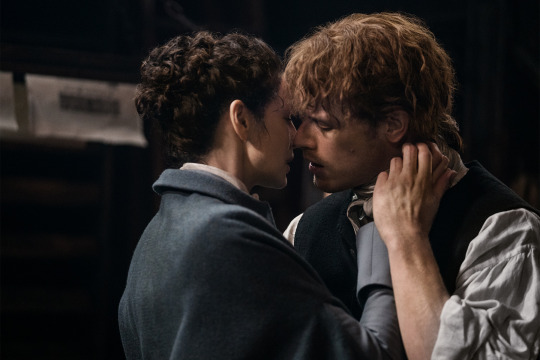
Claire and Jamie (Caitriona Balfe and Sam Heughan) enjoy their reunion in A. Malcolm’s print shop (Photo: Starz)
Warning: This post contains spoilers for the “A. Malcolm” episode of Outlander.
A successful 18th century printer’s press like the one owned and operated by one A. Malcolm — a.k.a. James Alexander Malcolm MacKenzie Fraser — doesn’t just spring up overnight. No, the lovely Edinburgh-based print shop where Outlander‘s long separated couple, Jamie and Claire, had their six-episodes-in-the-making reunion on this week’s super-sized installment took well over a year of careful planning and construction by the show’s production design team, headed by Jon Gary Steele. Speaking with Yahoo Entertainment, Steele reveals that his crew started work on A. Malcolm’s shop midway through shooting the show’s second season. “Halfway through one season, we always start on the next,” he says, which means his team is already deep into designing Season 4 while Season 3 is still airing. “It takes a lot of time to get these sets done.”
And key sets like the print shop are treated with exceptional care. Not only is it the scene of what’s arguably the season’s emotional high point so far, but it’s also an environment that fans of the Outlander novels have been waiting to see brought to life… and they’ll know if the details aren’t exactly right. Fortunately, Steele is as detail-minded as the show’s devoted fan base, whether he’s building Jamie’s printing press or the brothel pied-à-terre where the Frasers continue their reunion. “The reaction we get from the fans makes us excited and proud, because they love the detail, so we work harder to make everything better each season,” he says.
We spoke with Steele about building a working version of “Bonnie,” Jamie’s beloved printing press, and the little details he hopes fans notice in the episode’s two major sets.
As I understand it, you built an actual printing press for Sam Heughan to operate in the print shop scene. Yes, we paid a specialist who does these recreations for universities, libraries, and museums, and had two of them built while we were filming Season 2. We also had someone come in and show Sam how to work it. Almost everything you see on that set was made [for the show]: every counter, every piece of print. I’ve had people ask me, “Why didn’t you put the print shop on one level?” I wanted two levels, because I thought it would be more visually interesting if Claire had to walk in and look down for the iconic scene of the reunion. I pitched it to Ron [Moore, the showrunner] and Matt [Roberts, the writer and producer] as it being a precursor to a factory. His store is upstairs, and then down below you can see all the workings. It was all built on one stage, and there’s catwalks and stairs that you can take. The downstairs was split in half with a wall of glass like the glass upstairs. It makes it more interesting for the camera. We didn’t want it to be a box: we wanted it to be possible for them to shoot it [from many angles].

Jamie hard at work over his beloved printing press, Bonnie (Photo: Starz)
Jamie names his printing press “Bonnie,” and in the book his name is carved on the frame. Did you replicate that detail? I don’t think we did. I wish we had remembered to do that! We tried to fill the set with detail and make sure that no matter where you looked, it looked period-correct and that there’s stuff to shoot through, as well as hanging paper drying everywhere. We did tons of research and saw that printing presses in the 1700s had these tool leather walls, so we did our own version of that. That’s the most ornate part, and it’s in the store where Claire comes in. It’s more utilitarian downstairs.
Is this the model for how a well-off printing press might have looked in the 18th century versus a less-successful publisher? Yes it was. We try to make everything look beautiful; even the ugliest stables, we try to make look as real as possible, but also beautiful in a way. And that’s what we tried to do here. For example, we spent a lot of time on the “A. Malcolm” sign that hangs outside. We knew it was a hugely important thing for fans of the book. I told the graphics people that I wanted to put lots of symbols into the sign, so we did all sorts of research into different symbols and incorporated them. There’s tin, because there’s tin in the press, as well as Jamie and Claire’s initials. We also wanted to be able to shoot through it so they could have camera on one side, while Claire comes up to it on the other. And they really did make signs like that: they were cast-iron and were pierced, so we tried to make it period-correct like that.
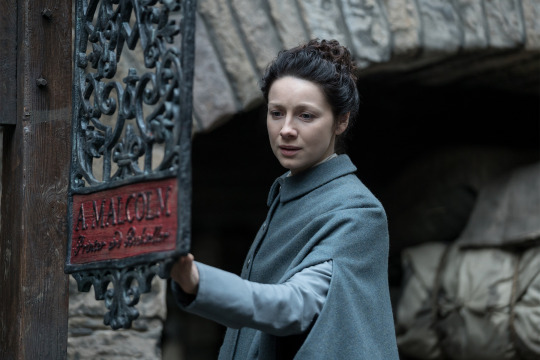
Claire examines the sign for A. Malcolm’s print shop (Photo: Starz)
Like many of the sets, the printing press is predominantly lit by candlelight. How does that factor into your designs? We worry a lot about it. Back in Season 1, we used to joke that everything had to be brown with a bit of gray. It’s been fun to see more color appear. There’s a lot of red in the printing press, and we couldn’t use red in Season 1 because that was the color of the redcoats only! But everything is thought about with the candle in mind. We have candles, candelabras, and chandeliers on almost every set, and we also build fireplaces because that’s what they did in the 18th century: it was a source of heat and light. For exteriors, we have metal braziers. The DPs love them, and they look really good on film. When you shoot in a courtyard, it adds a little burst of golden color. We always take samples of colors and fabrics and hold them up next to the costumes, with candles next to that to see if they look good in candlelight or not. The DPs always make it look beautiful.
What’s one detail about the printing press you hope viewers at home notice? My favorite part is the storeroom upstairs because of the walls. We put little bits of gold on the molding around the doorways and the bookcases when you walk into the room. I remember a carpenter going, “You want gold in the touch-up?” I told him that it’s just a highlight. When it’s lit with the candles and chandeliers, the gold shimmers in the light. That’s my favorite thing. Also, the tool leather walls that aren’t tool leather, but look like it!
Let’s turn to the Edinburgh brothel. You’ve designed a lot of brothels for the show already. How did you want this one to stand apart? What I was trying to do was take this space and cover it in old rugs to make it look like a harem. The way I described it to Ron was, “I want to put built-in daybeds everywhere, with one in the center for the madam. And then everything around the openings will be covered with rugs.” He was like, “Rugs?” And I said, “Yeah, rugs. It’s not Paris — it’s more downscale.” We were trying rugs, and at first none of them matched, but then we found some we loved and made duplicates and covered the walls in the whole place so it creates a tapestry of rugs. And it works! It’s crazy, but it works. [Laughs]
And that was entirely your own invention? This is my fourth year on the show, and you always want to do something different. We’ve done tons of taverns and a couple brothels before, and we know fans love this stuff. So even though it has to be period correct, we want [each set] to be special. Everyone on this show wants it to be special in every scene and in every detail, be it the armorer who does the guns or the set decoration or the costume designers or the props department. When you see Claire’s medicine kit for the next season, it’s like a piece of art — it’s stunning.

Jamie and Claire continue their reunion at Jamie’s apartment above a brothel (Photo: Starz)
Speaking to the beauty aspect, Jamie’s private room does seem a bit more romantic than an actual brothel likely would have been. Anywhere that Jamie and Claire are going to have a romantic scene we try to make as sexy as we can, even if it’s a barn. They ended up having more scenes there than we thought, and the crew was actually a little angry about shooting in this little room. I was like, “This is way bigger than it should be. It’s really just a room in a brothel — this is the triple the size!” They need that room to shoot; it all works out and looks great.
Since they have to film so many intimate scenes, do Sam Heughan or Caitriona Balfe have special requests in terms of the kind of mattress or bedding they prefer to lie on? We only try to make sure the bed’s big enough for Sam, because he’s 6’3″ long! There was one scene where the rug they were going to be on was really abrasive, so we had to swap that out. But they’re very kind and generous to us, and never really ask for anything from us. They always come and say thank you to all the departments about how beautiful everything is. That’s a good thing, because we’ve all been on projects where it’s not like that.
Any hidden details about the brothel you want to call out to eagle-eyed fans? We put these little columns on the madam’s daybed. It was built especially for her so she could lounge on this giant daybed with thousands of pillows — kind of like an opium den, but it’s Scotland! So we put these big twist columns on there, as well as the fireplace mantles. Someone said, “That’s a little bit much for a brothel,” and I said, “If you can’t do it in a brothel, you can’t do it anywhere!” There’s certain sets that have to be exactly period correct, but we try to have fun with it [when we can].
Most of your pre-Outlander production design credits are films that take place in contemporary settings. Has it been fun living in the past for three seasons? I love it! It’s the most fun stuff I’ve ever done. I love doing things like American History X and Cruel Intentions also, but it’s a dream to do the 18th century, because it’s such a beautiful period for design. We build so much stuff and research continuously; everybody in the department is always looking through books or magazines, and Google is huge. What’s interesting is that in Season 1, we would type “18th century” into Google and you’d get Game of Thrones or other period shows. Now when we’re researching stuff, we see pieces of our own sets! I should have stock in Google. [Laughs]
Outlander airs Sundays at 8 p.m. on Starz.
Read more from Yahoo Entertainment: Notes from our ‘Outlander’ wine tasting ‘Outlander’ Postmortem: Toni Graphia on writing the prelude to the print shop scene: ‘Stay tuned!’ ‘Outlander’ postmortem: Duncan Lacroix talks Murtagh Fraser’s surprise resurrection
#caitriona balfe#_revsp:wp.yahoo.tv.us#starz#_author:Ethan Alter#outlander#_uuid:85398f04-8db5-3e5a-bd9c-d24d78aacda0#_category:yct:001000086#sam heughan#_lmsid:a0Vd000000AE7lXEAT#interviews#Jon Gary Steele
246 notes
·
View notes
Text
Amazons Attack! - part 1
Once upon a time, in the lead-up to the 2005-2006 cesspool of a crossover event that was “Infinite Crisis”, DC had plans for a miniseries called “Amazons Attack!”. The story was to be helmed by then-Wonder Woman writer Greg Rucka and artist Ethan Van Sciver, and it would deal with a conflict between the Amazons and the United States following Diana’s killing of Max Lord (and, presumably, building off the simmering background tensions between the two nations since the floating islands of Themyscira had crashed into the ocean off the coast of the US in early 2004).
The idea was nixed, but it never entirely went away. Over the next few years, it passed through the hands of numerous people at DC before finally landing in the lap of Will Pfeiffer in late 2006. By this stage, the original proposal was no longer feasible. The Max Lord story had been resolved, Themyscira had retreated entirely from the mortal plane, and there was no longer any interaction between the Amazon and American peoples.
But that wasn’t gonna stop DC from achieving their glorious vision of man-hating harpies attacking the US capital with swords and pointy sticks.
Around this same time, somebody else in the company had a genius idea. Jodi Picoult, a bestselling author with a strong following among women readers, had just released a new novel about family relationships and trauma, and one of the main characters happened to be a comic book artist. Why didn't they find out if Picoult was interested in writing an actual comic and, you know, lending DC some of that New York Times Bestseller cred?
Picoult wasn’t sure. She didn’t know if she had the time, let alone the interest, in the project. She’d never been much of a Wonder Woman fan. But her kids talked her into accepting, and so, with no previous comic writing experience and far too little editorial guidance, Jodi Picoult set out to make her mark on Wonder Woman.
Together, Picoult and Pfeiffer would craft one of the most widely-derided stories in Wonder Woman’s history. There would be crimes against the written word. There would be character assassination on a mass scale. There would be bees.
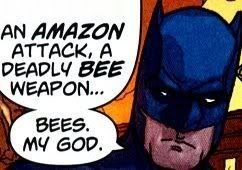
Part 1: Wonder Woman volume 3 #6 -- Jodi Picoult (writer) and Drew Johnson (artist)
Some context: For reasons too stupid to go into, Diana has decided to assume a secret identity. She hopes to can gain a better understanding of those she protects by living a normal human life… as an elite Department of Metahuman Affairs field operative charged with neutralising metahuman threats.
Agent Diana Prince is standing in a scungy restroom trying to remind herself that she’s not Wonder Woman. She’s doing that thing where the hero looks in the mirror and sees their alter ego reflected back at them, but due to some poor art decisions, it instead looks like she’s staring at a Wonder Woman poster that somebody has hung over a grotty sink.
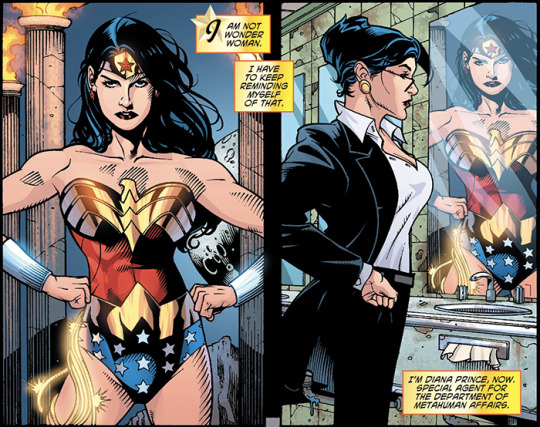
More bad art choices occur in the next panel, where the mirror glowers at her behind her back.
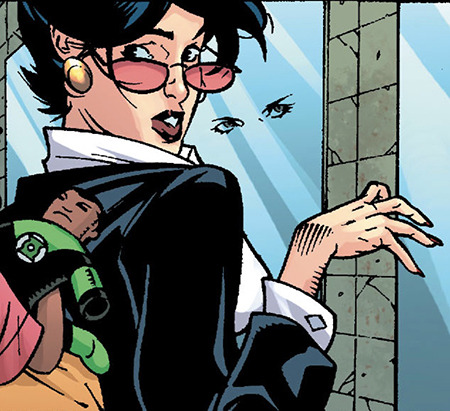
Diana continues to puzzle over how having a secret identity is really hard since she doesn’t know the first thing about how to be a human being. Because it’s not as though a large part of Wonder Woman’s career as a public figure in Man’s World has been working as an ambassador and engaging with people across the world at all levels of society or anything.
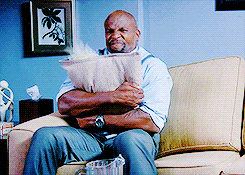
Also, Jodi Picoult misspells “Themysciran” twice and both typos are left uncorrected, setting the standard for the number of editorial fucks given in this crossover.
Then she steps out of the restroom and into a superhero-themed amusement park, where we meet Diana Prince’s charmer of a partner, Tom Tresser.
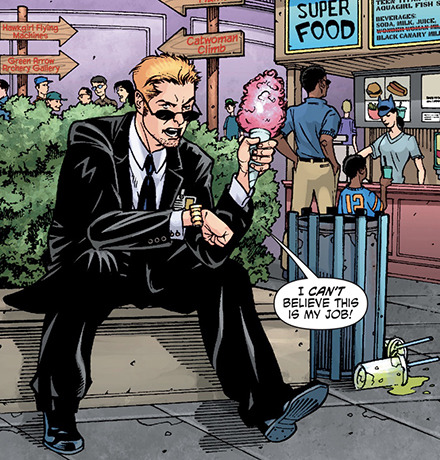
“I can’t believe this is my job!” Tom exposition/whines. “I can’t believe we have to baby-sit some sore loser who won a reality TV show to become the new Maxi-Man! I can’t believe you are my partner! I can’t believe cotton candy costs four dollars now…!”
I can’t believe I’m reading this fucking crossover.
Diana diplomatically replies that she’s not used to working with a partner either, and Tom sneers that, based on what he’s read in her record, she’s “not used to working, period”. Because Batman was skilled enough to build an entirely new identity for Diana, but not smart enough to give her an employment history…? How the frig did she get hired by the DEO, then?
Also, great to see that Diana and Tom are both taking their assignment to prevent a human person from dying so seriously. While Maxi-Man is signing autographs out in the open, a sitting duck for any would-be attacker, Tom is gorging himself on fairy floss and Diana is trying to order a Wonder Woman-branded milkshake.
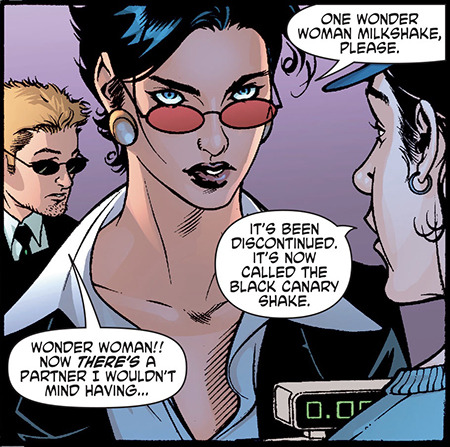
Diana: One Wonder Woman milkshake, please. Server: It’s been discontinued. It’s now called the Black Canary shake. Tom: Wonder Woman!! Now there’s a partner I wouldn’t mind having…
In case you hadn’t figured it out, Tom Tresser is the love interest. Whatta catch.
Also, no, Jodi. No. Either the Wonder Woman milkshake has been discontinued, or it’s been renamed the Black Canary milkshake. You can’t have it both ways.
This, by the way, is the first of several “hilarious” gags about how Wonder Woman is unpopular and regarded as kind of uncool. Picoult’s going for cheeky meta, but she comes off as ignorant, tone deaf and kind of mean-spirited.
In the real world, Wonder Woman doesn’t share the same level of popularity as Superman and Batman. But in the DC Universe, and particularly in the Wonder Woman comic, she’s consistently portrayed as a hero with a strong public presence and an ability to inspire, to the point where literally the issue preceding this one was a oneshot revolving around Wonder Woman’s influence as an empowering and inspiring hero.
If Picoult was playing, as Rucka did, with the idea that once Wonder Woman started using her public status to express her opinions, a large swathe of the public turned against her, that’d be one thing. But, no, she’s just decided, as a basis for her punchline, that Wonder Woman is a nonentity in the DCU, which is out of step with canon and does a huge disservice to the character.
As a meta joke, this also misses the point, because the fact that Wonder Woman doesn’t sell as many comics as Batman and Superman cannot be divorced from the the historical (and persistent) sexism in what remains a very blokey, male-dominated industry, not to mention the fact that DC put significantly more resources into producing and promoting Batman and Superman comics and merch. Those aren’t the only reason for the discrepancy in popularity, but they’re not things you can just brush off.
It gets even more unfortunate in the context of this particular comic’s publication. See, about ten months prior to this, DC had relaunched Wonder Woman with a new #1 issue penned by Allan Heinberg, who had recently earned much acclaim as the writer and co-creator of Young Avengers at Marvel. Between them, Heinberg and DC then proceeded to royally fuck up the relaunch. Heinberg wasn’t able to balance scripting duties with his TV writing job, causing issues to be delayed for months at a stretch, until it became clear there was no way he’d be able to finish his first arc before Jodi Picoult started her run and DC had to move on without him (he would eventually finish his story in the 2007 annual — over a year after he started the five-issue arc). Picoult’s first issue was only the third Wonder Woman comic to hit the stands in more than six months.
So basically, she’s making her funny-funny “boo, nobody buys Wonder Woman” against a backdrop of DC failing to produce Wonder Woman comics for months on end.
Anyway. Diana and Tom finally get around to doing their job and return to Maxi-Man’s signing table. Maxi-Man asks them to get him a chilli dog (“and a drink! I hear the Black Canary shakes are awesome!” GROANS FOREVER), and Tom has the nerve to be offended. “I don’t remember seeing this in my job description.” Well, gee, Tom, I don’t remember seeing ‘leaving your principal unprotected so you can slack off and stuff your gob with fairy floss’ in the job description either, and yet here we are.
Tom continues to grizzle about how unfair it is that his incredible talents are being wasted on this boring assignment, and this time Diana’s starting to get fed up. Meanwhile, the reality-show superhero they’ve been looking down their noses at is the only one who’s noticed that the rollercoaster behind them is spontaneously falling apart.
Of course, the moment Maxi-Man springs into action, he’s immediately knocked out cold by a piece of flying rubble, leaving Diana to take charge. Tom does what he does best, by which I mean he complains.
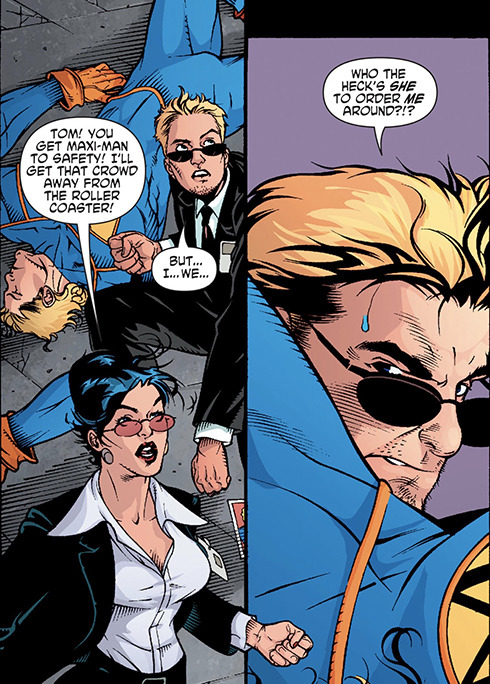
Diana: Tom! You get Maxi-Man to safety! I’ll get that crowd away from the roller coaster! Tom: But… I… we… Diana: There’s no time! Now! Tom: Who the heck’s she to order me around?!?
A quick costume change, and Wonder Woman saves the day, but not without internally griping about how stupidly confusing humans are.
Maybe this is what I was born for. To protect them… not understand them. But how can I…? They don’t even understand themselves.
urrrgghghhhhhh haaaaaate.
We never learn why the roller coaster spontaneously fell apart.
Later, as Diana and Tom make their way back to DOMA, Tom is still complaining. This time it’s about the fact that he missed Wonder Woman’s appearance at the theme park, because “I bet she looked hot”.
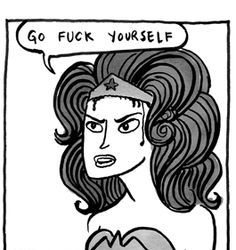
They stop at a store selling superhero merch so that Tom can get his niece a Wonder Woman action figure for her birthday. Diana comments that she thought Tom was an only child and Tom conspicuously doesn’t answer. And sure, it’s possible that the “niece” is a real human person who’s the daughter of a close friend or non-sibling relative, but given everything we’ve learned about Tom in the last eight pages, I think it’s far more plausible to assume that there is no niece and he’s planning on jerking off to a Wonder Woman action figure.
Diana continues to be terrible at having a secret identity.
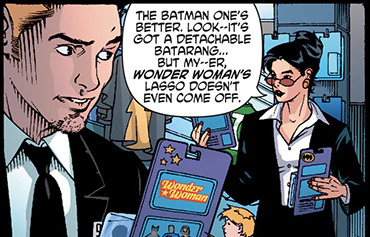
“The Batman one’s better. Look — it’s got a detachable Batarang… But my — er, Wonder Woman’s lasso doesn’t even come off.”
All the Wonder Woman merch is 75% off because lol Wondy is uncool, and for some reason Diana is super offended and tries to lecture the poor store clerk about how obviously Wonder Woman is cool because saving the world is cool so there.
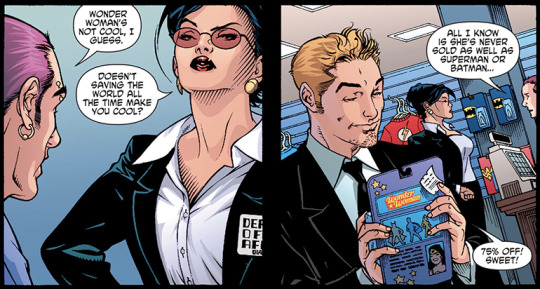
Clerk: Wonder Woman’s not cool, I guess. Diana: Doesn’t saving the world all the time make you cool? Clerk: All I know is she’s never sold as well as Superman or Batman… Tom: 75% off! Sweet!
Next, it’s time for a stop off at the gas station for some hilarious comedy hijinks around Diana’s total lack of familiarity with modern society!
Ha ha! Champagne comedy! All of this is just so new to her, don’t you know! It’s not like she’s ever lived among ordinary mortals
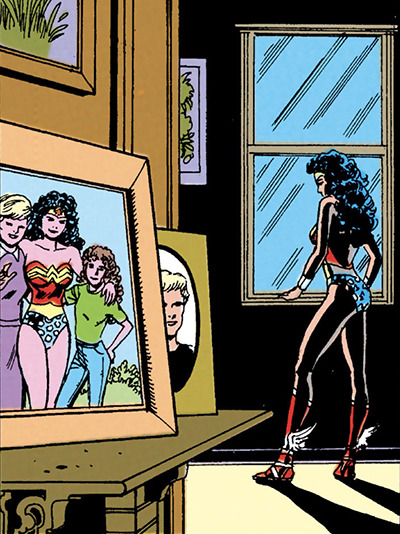
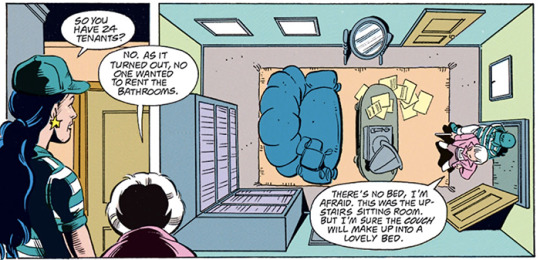
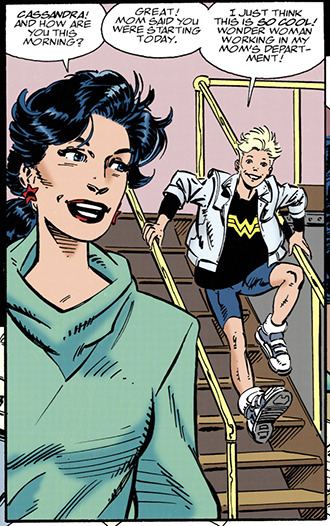
or held down a job
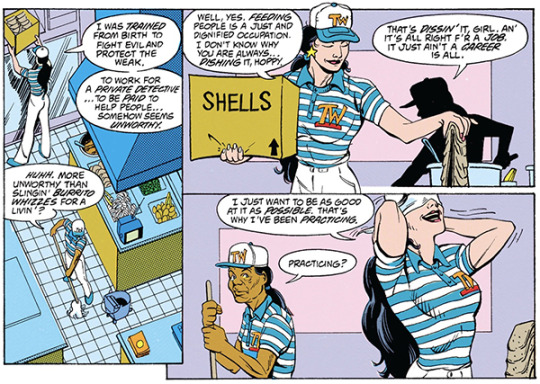
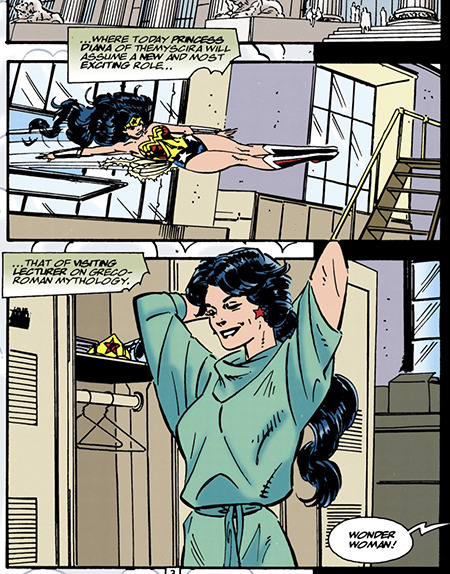
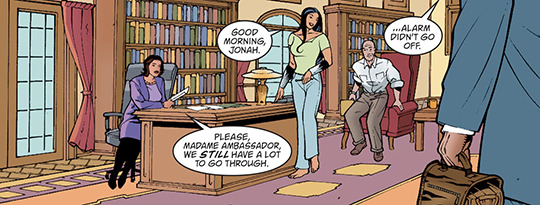
or, you know, interacted with any human being at length.
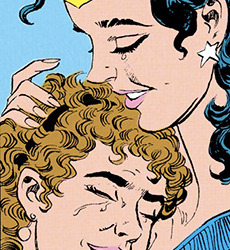
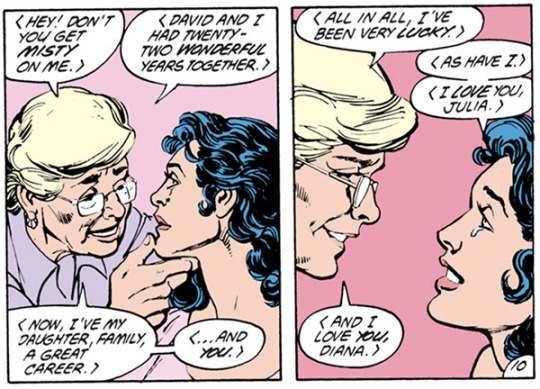

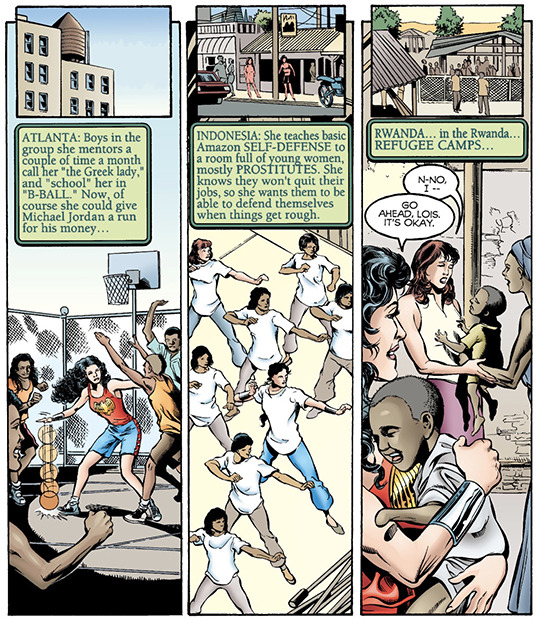
Now, I don’t blame Jodi Picoult for not knowing any of this. I’d be surprised if she’d even read a Wonder Woman comic before DC approached her, and though she would have done some background reading in preparation for this gig, she couldn’t be expected to be across every element of Wondy’s post-Crisis continuity, which at that point already stretched back two decades.
Her editors, however? Were not new to comics. They should have picked this shit up.
So, they go to get gas. Tom asks Diana to pay and she pulls out a ten dollar note. Tom points out this is insufficient in the most patronising way possible.
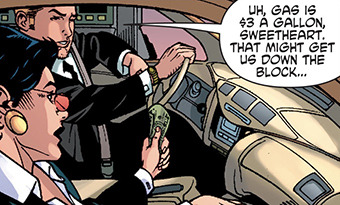
“Uh, gas is $3 a gallon, sweetheart. That might get us down the block…”
He asks he if she has a credit card, and she blinks in incomprehension. Yeah, because it’s not like Batman would have arranged cards and a credit history when he manufactured Diana’s false identity. Not like he’s known for being detail-oriented or anything. (And by the way, this is a thing that happened four fucking issues ago, so nobody has any excuses.)
Aaaaand Diana continues to suck at the secret identity thing.
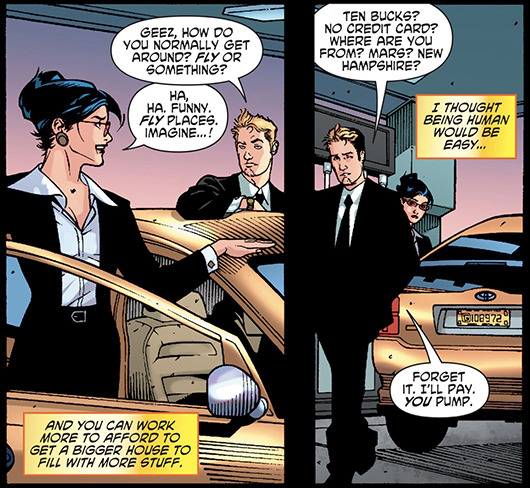
Tom: Geez, how do you normally get around? Fly or something? Diana: Ha, ha. Funny. Fly places. Imagine…! Tom: Ten bucks? No credit card? Where are you from? Mars? New Hampshire?
Oh yeah, and this whole scene she’s been internally complaining about how humans are relentlessly acquisitive and materialistic and confusing and booooooo being an ordinary person is haaaaaaard.
Finally, they arrive back at HQ, where Sarge Steel chews them out for allowing a known fugitive like Wonder Woman to slip through their fingers at the amusement park, even though they weren’t at the park for Wonder Woman and this is literally the first they’re learning that Wonder Woman is a fugitive.
He also blames them for the rollercoaster getting destroyed, even though they had nothing to do with the damage and their only contribution was to get people to safety. Although, given how much they were slacking off on the job, it’s entirely possible that some metahuman terrorist snuck in and sabotaged the rollercoaster on their watch. Since Picoult still hasn’t told us how the rollercoaster was damaged, I’m just going to assume that this was the case.
It turns out that Wondy is wanted for questioning over her killing of Max Lord, even though she’s already been cleared of charges, so Tom and Diana’s new orders are to find her and haul her in. Awkwaaaaaard.
So obviously they get straight to work this important government assignment. I’m just kidding, they head straight for the DCU version of Starbucks. In fact, so far I haven’t come across any evidence that either of them do any work at all.
Things we’ve seen Tom and Diana do this issue:
Leave their principal unprotected so they can gorge themselves on junk food
Bicker and complain while a rollercoaster explodes behind them
Shop for superhero action figures
Fill up on petrol
Drink coffee
Things we have not seen Tom and Diana do this issue:
Their fucking job.
We get the usual obnoxious joke about Starbucks coffee sizes being weird and Diana being confused by them, which I’m pretty sure was hack material even in 2007.
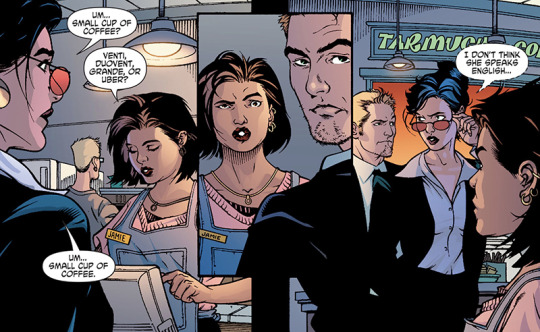
Tom: Iced double Vente soy latte with Turbinado sugar, please. Diana: Um… Small cup of coffee? Server: Venti, Duovent, Grande, or Uber? Diana: Um… Small cup of coffee. [Everyone stares at her.] Diana: [whispers to Tom] I don’t think she speaks English…
They sit in the park, drinking their coffee, and Diana cries because humanity is confusing and everybody is mean to Wonder Woman.
No, really, that’s exactly what happens.
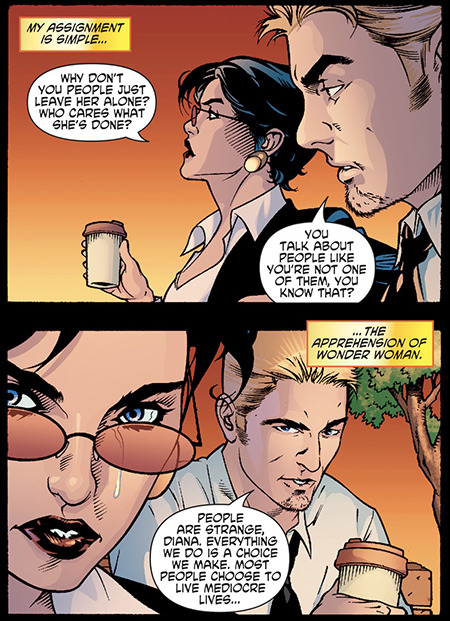
Diana: Why don’t you people just leave her alone? Who cares what she’s done? Tom: You talk about people like you’re not one of them, you know that? Diana: [CRIES]
Picoult’s Diana is so outrageously bad at maintaining a secret identity on even the most basic level, even a self-absorbed wanker like Tom Tresser ought to have cottoned onto her by now. Then again, he also failed to notice a rollercoaster collapsing a few metres away from him, so…
In an out-of-character display of ordinary decency, Tom gives Diana a pep talk, then heads off home. As he walks away, Diana hears a scream for help and jumps into action—
—aaaaaaand it’s an attractive young white college girl being mugged by a thuggish, armed black man. Definitely no ugly connotations lurking there.
Diana subdues him with a single punch, and is rewarded with proof that some people do still find Wonder Woman cool because, yes, we’re still on that tired gag.
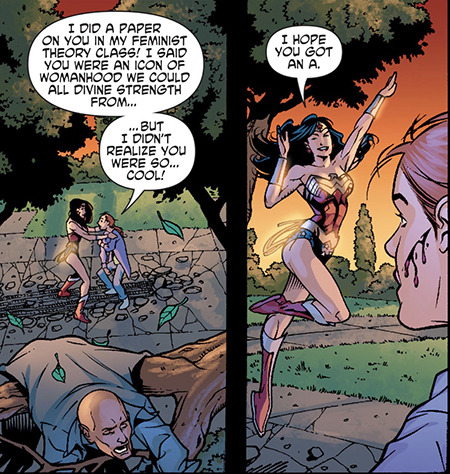
College girl: I did a paper on you in my feminist theory class! I said you were an icon of womanhood we could all divine strength from… but I didn’t realise you were so… cool! Diana: I hope you got an A.
Tom, driving home, gets a call that Wonder Woman has been sighted in a seedy part of town. In addition to illegally talking on his phone — not hands-free — while driving, he does that thing people do when they’re pretending to talk on the phone, you know, helpfully repeating all the relevant information for the audience.
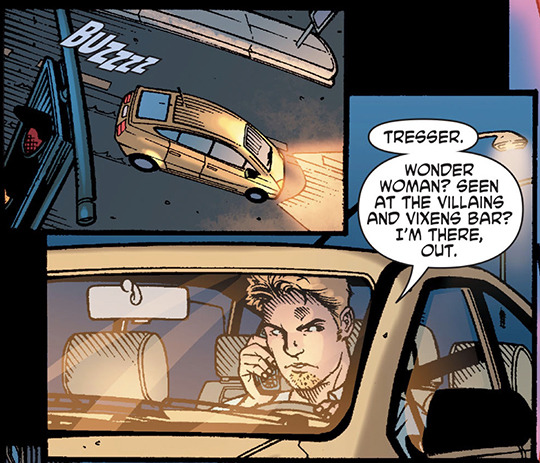
“Tresser. Wonder Woman? Seen at the Villains and Vixens Bar? I’m there, out.”
If we could hear both sides of the call, I can only imagine that it’d go something like—
Tom: Tresser.
Agent: Hey Tom, it’s Fred; hear you’re on the Wonder Woman case. I know it’s late, but we got a couple reports of sightings at the Villains and Vixens Bar. You happen to be anywhere near there?
Tom: Wonder Woman? Seen at the Villains and Vixens Bar?
Agent: Yeah, that’s what I just sa—
Tom: I’m there, out. [hangs up]
Agent: Jesus, I fucking hate that guy.
Basically what I’m saying is, he absolutely deserves it when he stumbles, ill-equipped, into a suspiciously flirtatious Wonder Woman who is wearing an earlier iteration of Diana’s costume and striking all kinds of ridiculous sexy poses, and instantly gets himself captured by what is obviously Circe in disguise.
Diana gets called back to headquarters, and she’s still wrestling with the question of how she can possibly do her job when her job is to arrest Wonder Woman. (WELL GEE, DIANA, I GUESS YOU SHOULD HAVE THOUGHT OF THAT BEFORE YOU TOOK A JOB UNDER AN ASSUMED IDENTITY AT THE DEPARTMENT DEVOTED TO POLICING METAHUMANS LIKE YOU.)
Also turnstiles. She is deeply perplexed by turnstiles.
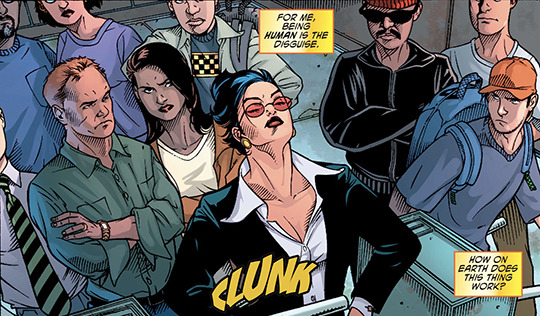
comedyyyyyyyyyy
Sarge tells Diana that Tom has been abducted and a pair of Amazon bracelets were found at the scene. This is all the evidence Sarge needs to conclude that Wonder Woman has gone back to her old neck-snapping ways and must be stopped. He gives Diana the bracelets in an evidence bag and tells her to take them to the lab and see what she can find out.
I have questions.
Why weren’t the bracelets already being analysed at the lab? Did Sarge Steel wrestle the evidence bag off a hapless crime scene investigator and smuggle them up to his office just so he could play show-and-tell with Diana? How do they know the bracelets are Wonder Woman’s? In this superhero-merch-flooded world, wouldn’t Amazon bracelets be a dime a dozen? Or is Wonder Woman so ~uncool~ that every Amazon bracelet manufacturer immediately went out of business and buried the shameful evidence of their failed ventures in a New Mexico landfill alongside all those Atari cartridges? And why would Wonder Woman leave her bracelets behind? They’re not the kind of thing she’s likely to forget. Yes, we know Circe’s planted the bracelets deliberately, but the DOMA agents don’t.
And most importantly, why does Sarge Steel’s reflection look like Diana?
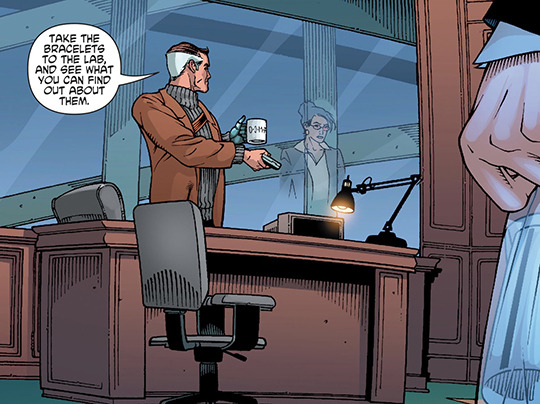
Diana doesn’t need to take the bracelets to the bag, because she knows they’re replicas and, what’s more, she knows where they come from.
“They were designed to complete a uniform I donated to the Wonder Woman Museum… which closed down over a year ago.”
Okay, now hang on.
I realise we’re back on the hilarious ‘Wonder Woman isn’t popular’ gag, which absolutely has not outstayed its welcome, but a museum is not the same thing as a theme park concessions stand or a pop culture store. A museum does not just go, ‘buhhhhh, I know we’ve amassed this huge collection of great historical, social and aesthetic significance. Indeed, it is almost certainly the largest collection of Wonder Woman and Amazon-related items in the world, and much of it was donated by Diana herself, making it immensely valuable. But — and this is awkward — it turns out people don’t want to visit us because Wonder Woman isn’t cool. Guess we have no other choice but to pack it in and open a Black Canary Museum down the road.” That is not how museums work, Jodi.
I’m also confused as to why Circe needed to steal a Wonder Woman costume from a museum when it would have been far easier to glamour her clothing to look like Diana’s, the same way she glamoured her features. This seems needlessly complicated.
Diana whips off her glasses and does the spinny-transformy thing from the TV show. This is technically a power that Wondy has at this point in continuity — at the end of Allan Heinberg’s first arc, it’s revealed that Circe has given Diana the supremely useless “gift” of being able to turn her powers off, allowing her to switch between Amazon and mortal with a spin and a flourish.
Except, when this issue was published… Heinberg’s last issue hadn’t been. Remember, he flaked on his scripting duties, so the final instalment of his story and the introduction of the dumbass spinny-power-up wouldn’t come out until November 2007 — six months after this issue was released.
The issue ends on Wondy flying to the rescue while Circe lies in wait in the defunct Wonder Woman Museum, predatorily clutching a chained and shirtless Tom Tresser.
35 notes
·
View notes
Text
YOUNG MATRONS’ LEAGUE TRYOUTS
October 2, 1948
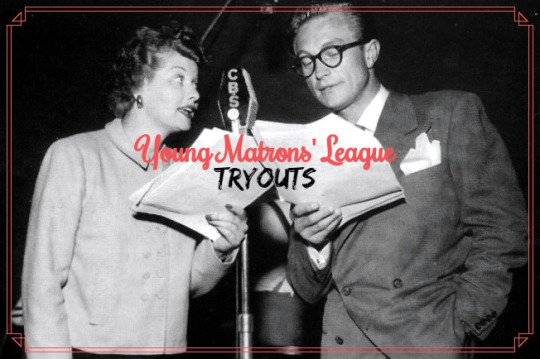
"Young Matron’s League Tryouts” is episode #11 of the radio series MY FAVORITE HUSBAND broadcast on October 2, 1948.
Synopsis ~ Liz tries to butter up George in hopes that he'll let her try out for the play that the Young Matrons League will be performing.
Note: This episode was aired before the characters names were changed from Cugat to Cooper. It was also before Jell-O came aboard to sponsor the show and before the regular cast featured Bea Benadaret and Gale Gordon as the Atterburys.
This was the first episode scripted by Jess Oppenheimer. The show moved from Fridays at 9:00-9:30 pm to Saturdays at 7:00-7:30 pm.
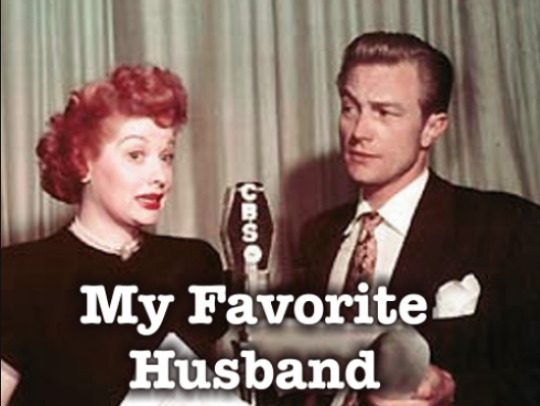
“My Favorite Husband” was based on the novels Mr. and Mrs. Cugat, the Record of a Happy Marriage (1940) and Outside Eden (1945) by Isabel Scott Rorick, which had previously been adapted into the film Are Husbands Necessary? (1942). “My Favorite Husband” was first broadcast as a one-time special on July 5, 1948. Lucille Ball and Lee Bowman played the characters of Liz and George Cugat, and a positive response to this broadcast convinced CBS to launch “My Favorite Husband” as a series. Bowman was not available Richard Denning was cast as George. On January 7, 1949, confusion with bandleader Xavier Cugat prompted a name change to Cooper. On this same episode Jell-O became its sponsor. A total of 124 episodes of the program aired from July 23, 1948 through March 31, 1951. After about ten episodes had been written, writers Fox and Davenport departed and three new writers took over – Bob Carroll, Jr., Madelyn Pugh, and head writer/producer Jess Oppenheimer. In March 1949 Gale Gordon took over the existing role of George’s boss, Rudolph Atterbury, and Bea Benaderet was added as his wife, Iris. CBS brought “My Favorite Husband” to television in 1953, starring Joan Caulfield and Barry Nelson as Liz and George Cooper. The television version ran two-and-a-half seasons, from September 1953 through December 1955, running concurrently with “I Love Lucy.” It was produced live at CBS Television City for most of its run, until switching to film for a truncated third season filmed (ironically) at Desilu and recasting Liz Cooper with Vanessa Brown.
MAIN CAST
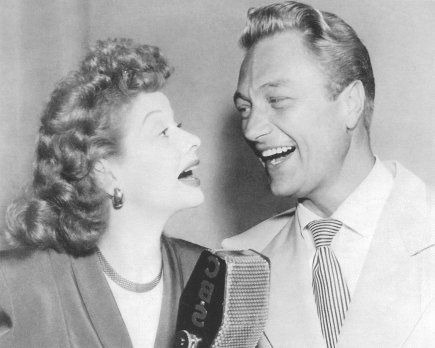
Lucille Ball (Liz Cugat) was born on August 6, 1911 in Jamestown, New York. She began her screen career in 1933 and was known in Hollywood as ‘Queen of the B’s’ due to her many appearances in ‘B’ movies. “My Favorite Husband” eventually led to the creation of “I Love Lucy,” a television situation comedy in which she co-starred with her real-life husband, Latin bandleader Desi Arnaz. The program was phenomenally successful, allowing the couple to purchase what was once RKO Studios, re-naming it Desilu. When the show ended in 1960 (in an hour-long format known as “The Lucy-Desi Comedy Hour”) so did Lucy and Desi’s marriage. In 1962, hoping to keep Desilu financially solvent, Lucy returned to the sitcom format with “The Lucy Show,” which lasted six seasons. She followed that with a similar sitcom “Here’s Lucy” co-starring with her real-life children, Lucie and Desi Jr., as well as Gale Gordon, who had joined the cast of “The Lucy Show” during season two. Before her death in 1989, Lucy made one more attempt at a sitcom with “Life With Lucy,” also with Gordon.
Richard Denning (George Cugat) was born Louis Albert Heindrich Denninger Jr., in Poughkeepsie, New York. When he was 18 months old, his family moved to Los Angeles. Plans called for him to take over his father’s garment manufacturing business, but he developed an interest in acting. Denning enlisted in the US Navy during World War II. He is best known for his roles in various science fiction and horror films of the 1950s. Although he teamed with Lucille Ball on radio in “My Favorite Husband,” the two never acted together on screen. While “I Love Lucy” was on the air, he was seen on another CBS TV series, “Mr. & Mrs. North.” From 1968 to 1980 he played the Governor on “Hawaii 5-0″, his final role. He died in 1998 at age 84.
Ruth Perrott (Katie, the Maid) was also later seen on “I Love Lucy.” She first played Mrs. Pomerantz, a member of the surprise investigating committee for the Society Matrons League in “Pioneer Women” (ILL S1;E25), as one of the member of the Wednesday Afternoon Fine Arts League in “Lucy and Ethel Buy the Same Dress” (ILL S3;E3), and also played a nurse when “Lucy Goes to the Hospital” (ILL S2;E16). She died in 1996 at the age of 96.
Bob LeMond (Announcer) also served as the announcer for the pilot episode of “I Love Lucy”. When the long-lost pilot was finally discovered in 1990, a few moments of the opening narration were damaged and lost, so LeMond – fifty years later – recreated the narration for the CBS special and subsequent DVD release.
GUEST CAST
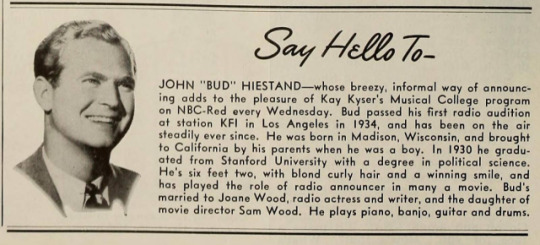
John Hiestand (Cory Cartwright) served as the announcer for the radio show “Let George Do It” from 1946 to 1950. In 1955 he did an episode of “Our Miss Brooks” opposite Gale Gordon.
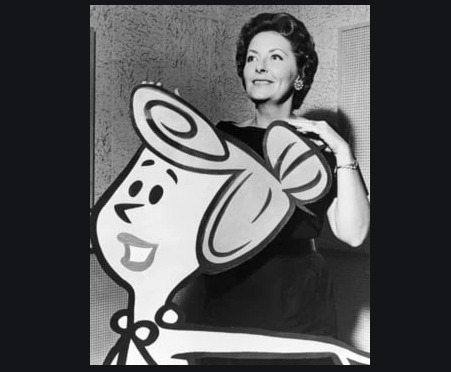
Jean Vander Pyl (Ann) is best known as the voice of Wilma Flintstone for the Hanna-Barbera cartoon “The Flintstones.” Coincidentally, Wilma’s best friend was voiced by Bea Benadaret, who will later play Iris Atterbury, Liz’s best friend on “My Favorite Husband.” On radio she was heard on such programs as “The Halls of Ivy” (1950–52) and on “Father Knows Best” before it moved to TV. She died in 1999 at age 79.
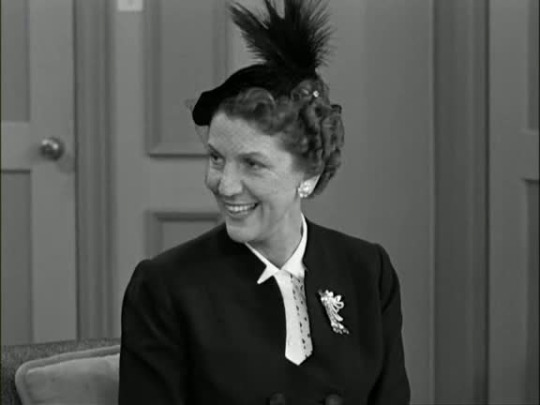
Elvia Allman (Miss Worthingill) was born on September 19, 1904 in Enochville, North Carolina. She started her performing career on radio in the 1920s, as both a storyteller and singer. Allman’s first episode of “I Love Lucy” is also one of the most memorable in TV history: “Job Switching” (ILL S2;E1) in September 1952. She played the strident foreman of Kramer’s Candy Kitchen. Allman returned to the show as one of Minnie Finch’s neighbors in “Fan Magazine Interview” (ILL S3;E17) in 1954. Changing gears once again she played prim magazine reporter Nancy Graham in “The Homecoming” (ILL S5;E6) in 1955. She made two appearances on “The Lucy–Desi Comedy Hour“ - first as Ida Thompson, Westfield’s PTA director in “The Celebrity Next Door” (LDCH S1;E2) and as Milton Berle’s secretary when “Milton Berle Hides Out at the Ricardos” (LDCH S3;E1) in 1959. On “The Lucy Show” she was seen in “Lucy Bags a Bargain” (TLS S4;E17) and in “Lucy The Babysitter” (TLS S5;E16). Allman died on March 6, 1992, aged 87.
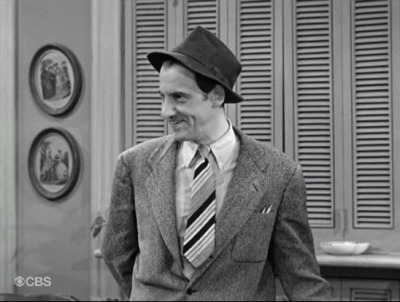
Hans Conried (Dr. Rhineholdt Schweinkampf, a Psychiatrist) first co-starred with Lucille Ball in The Big Street (1942). He then appeared on “I Love Lucy” as used furniture man Dan Jenkins in “Redecorating” (ILL S2;E8) and later that same season as Percy Livermore in “Lucy Hires an English Tutor” (ILL S2;E13) – both in 1952. The following year he began an association with Disney by voicing Captain Hook in Peter Pan. On “The Lucy Show” he played Professor Gitterman in “Lucy’s Barbershop Quartet” (TLS S1;E19) and in “Lucy Plays Cleopatra” (TLS S2;E1). He was probably best known as Uncle Tonoose on “Make Room for Daddy” starring Danny Thomas, which was filmed on the Desilu lot. He joined Thomas on a season 6 episode of “Here’s Lucy” in 1973. He died in 1982 at age 64.
Conried uses a broad German accent as the Psychiatrist, a common trope due to the popularity of Dr. Sigmund Freud.
THE EPISODE
ANNOUNCER: “Let’s look in on them now as Liz waits George to come down to breakfast…”
Liz tells Katie the Maid to cook the breakfast, but that she’ll serve it. She’s looking to butter up George for a favor.
The phone rings and it is Ann asking Liz to lunch. She declines because it is the afternoon of the Young Matrons’ League play auditions. She tells Ann that the famous Hollywood director Anatol Brodney (a former resident of Sheridan Falls) will be in the audience opening night! The audition notice is in the society column of today’s paper.
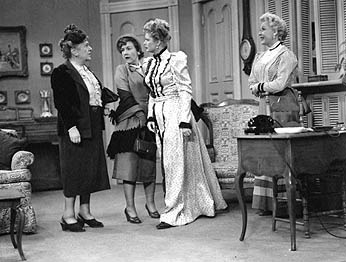
In “Pioneer Women” (ILL S1;E25) Lucy and Ethel are anxious to gain membership in a group called The Society Matron’s League if they can pass muster with its haughty examining committee, Mrs. Pettebone and Mrs. Pomerantz. This group is clearly modeled on The Young Matrons League on “My Favorite Husband,” a group that is mentioned in several episodes of the series. Although Lucy always declined to reveal her age, television was a visual medium so the word “young” had to be replaced!
GEORGE: “Are YOU cooking breakfast?” LIZ: “Well, you’re my favorite husband.” GEORGE: “What do you want from me, Liz?”
While waiting for his breakfast, Liz tells George to read the paper, which just happens to be open to the society column.
GEORGE (reading aloud): “Overheard at tea: People wouldn’t be so incompatible if the men had more income and the girls were more pattable!”
When George sees the audition notice, he calls the participants jackasses. Liz was in the play last year, so she takes issue with his assessment. George puts his foot down and won’t let Liz audition. She already knows that this year the play will be John Loves Mary.
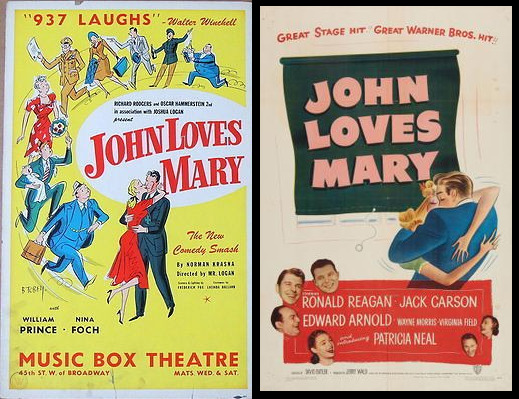
John Loves Mary was a real life comedy written by Norman Krausner that opened on Broadway at the Booth Theatre on February 4, 1947 before moving a month later to the Music Box Theatre for the remainder of its run. It closed on February 7, 1949 after 423 performances. The play won an award for Best Costumes at the very first Tony Awards in 1948. The cast included Max Showalter, who would guest star in several episodes of “The Lucy Show”. The play also served as the Broadway debut of Cloris Leachman, who understudied Nina Foch. In February 1949, just a few months after this broadcast, the film version was released, although it was in production during January and February. It was known for being the film debut of Patricia Neal, who took the role originated by Nina Foch on Broadway. The film starred Ronald Reagan, who, as President of the United States, would bestow Lucille Ball with her Kennedy Center Honor in 1986. It also featured Paul Harvey, who would play the New York Times art critic on “Lucy is a Sculptress” (ILL S2;E15). Irving Bacon (Mr. Willoughby and Will Potter) is also in the film. .
Liz tells George about the Hollywood director who is going to be in the audience and says she just might land a big Hollywood contract.
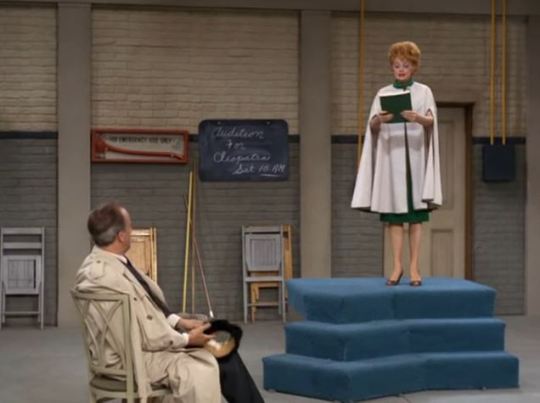
Liz is not the last Lucy character to try out for an amateur theatrical production. In 1963 Lucy Carmichael auditioned for the role of Cleopatra for the Danfield Community Players. She landed the role!
LIZ: “What has Betty Grable got that I haven’t got? Or Lana Turner?”
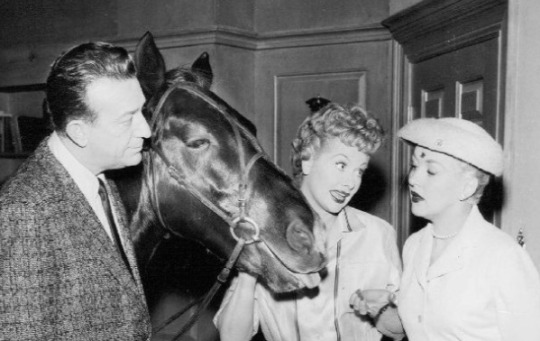
Betty Grable (1916-1973) made two films with Lucille Ball when they were both at RKO in the mid-1930s. She married actor Jackie Coogan in 1937 but divorced him in 1940. A pin-up girl, she was known for her shapely legs. In the late 1940s, 20th Century Fox insured her legs with Lloyd’s of London for a quarter of a million dollars. Although she never appeared on the half-hour "I Love Lucy,” the mention of her name alone often stirred Fred’s libido, much to Ethel’s chagrin. In “Ricky’s Screen Test” (ILL S4;E7) Grable is mentioned as one of Ricky’s possible Don Juan co-stars. Her final screen appearance was in a 1958 “Lucy-Desi Comedy Hour” playing herself opposite her husband, Harry James.
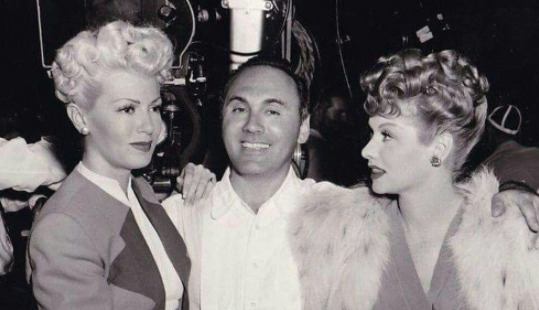
Lana Turner (1921-1995) was as famous for her tight-fitting sweaters as Grable was for her shapely legs. She had appeared as herself in DuBarry Was A Lady starring Lucille Ball in 1943. She was mentioned on three episodes of “I Love Lucy” but never appeared on the series.
Once George has gone to work, Liz quickly phones back Ann and tells her that although George has forbidden it, she is going to the audition anyway. She claims that she isn’t looking for Hollywood fame, but wants to be able to prove to George that she can get it.
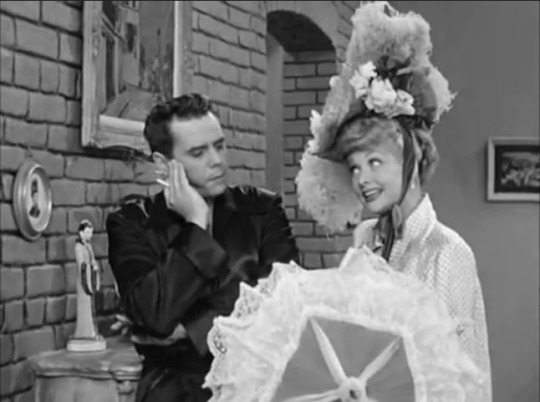
Housewife Liz’s search for fame is a character trait the writers would bring to Lucy Ricardo on “I Love Lucy.” The main difference is that Lucy truly wants to be famous, whereas Liz just wants to prove she has what it takes to get it!
Bachelor Cory Cartwright (John Heistand) drops by to report on his latest girlfriend, listed in his little black book as Mary Johnson, RHRW. The RH means Red Head and the second R stands for Real. (The audience laughs, perhaps knowing that Lucille Ball is NOT a real redhead.) The final letter is his kissing guide: W is for Wow! Liz asks if she is listed in his little black book? She is: Liz Cugat RHRWIWG. (Apparently Liz is supposed to be a real redhead). The WIWG stands for “Wish I Were George”! Liz demurs. Awww!
Cory lets it slip that he and George are having lunch with Anatol Brodney, who Cory knows from his college days. Liz wants Cory to bring George and Anatol home for dinner so that she can really show off her talent. He promises to try.
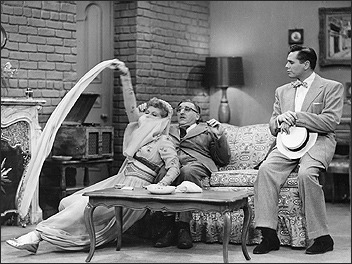
On “I Love Lucy,” the Ricardos and Mertzes also conspire to show off for a visiting Hollywood rep in “The Mustache” (ILL S1;E23). Lucy is a harem dancer, mainly due to the need to disguise the full beard she’s accidentally glued to her face. The Mertzes do an Arabian Nights act complete with snake charming, while Ricky croons ballads.
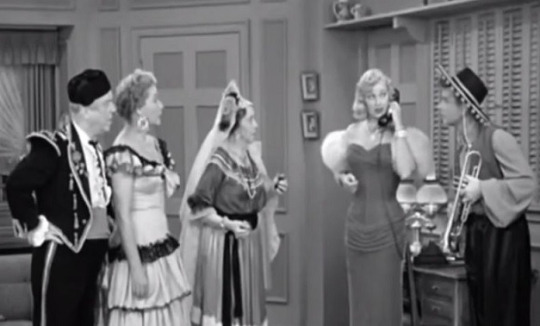
This idea would also be part of “Ricky’s Movie Offer” (ILL S4;E5), in which Lucy and the neighbors are sure that Ricky is bringing home a Hollywood talent scout, so they get their acts read. Lucy as Marilyn Monroe, Fred and Ethel as apache dancers, Mrs. Trumbull as a castanet singer, and the grocery delivery boy playing the trumpet!
At the auditions, Miss Worthingill of the Drama Department of Sixley College (Elvia Allman) is introduced to talk about her acting method. Liz gets up to audition for the role of a matron of 36, although she doesn’t think she can play someone quite so old. [Ball is actually 37 at time!] The scene involves displaying an array of emotions from laughter to tears, plus chastising a dog who won’t get off the sofa. Miss Worthingill deems Liz a strong contender for the part.
George unexpectedly comes home for some papers and is told by Katie that Liz came home and locked herself in her room. Listening at the door, they hear Liz rehearsing - first crying, then laughing, then barking like a dog. They overhear Liz say the line “Take me in your arms!” and George decides to go in and confront her. Searching the room, he whistles for the dog and looks in the closet and under the bed, naturally finding neither dog, nor secret lover!
LIZ: “What did you expect to find? The Toni twins?”
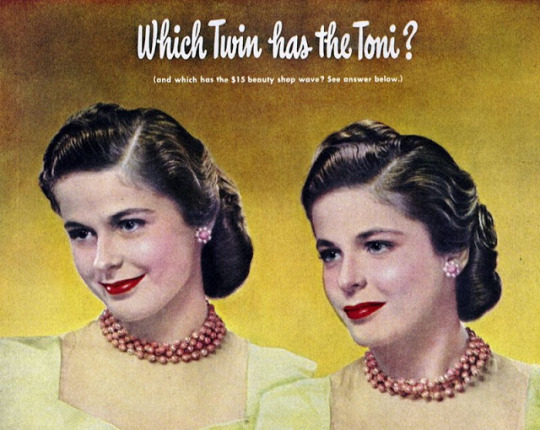
Liz is jokingly referring to a series of print ads for Toni Home Permanent that depicted two twins with identical hairstyles and asked which one had the Toni, and which one had the more expensive salon perm. The promotion was so popular that the slogan “Which Twin Has The Toni?” became a part of common parlance. In addition, the Toni name itself became the name for a generic home permanent. The Gillette Safety Razor Company acquired The Toni Company in 1948, the year of this broadcast.
To hide that she was rehearsing for her final audition, Liz tells George she had a nightmare. Or a ‘day-mare’, since it is daytime.
A worried George decides to talk to a psychiatrist (Hans Conried) for advice about Liz. Hearing George’s surname, the doctor asks:
DOCTOR: “Xavier?” GEORGE: “George! I can’t even hold a tune.”
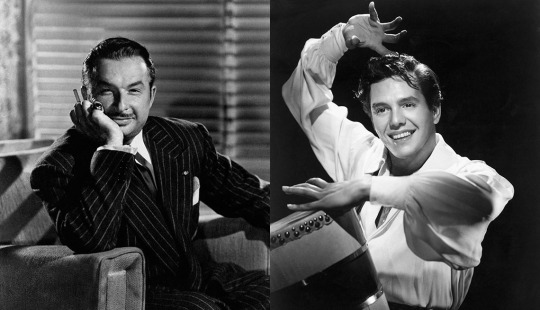
This is a reference to the Cuban bandleader Xavier Cugat (1900-1990). Lucille Ball’s husband Desi Arnaz was once employed by Cugat and looked at him as a mentor. Although the characters that inspired “My Favorite Husband” were originally named Cugat, it became apparent that there was confusion about the uncommon surname - especially considering the Arnaz / Cugat connection. By the end of 1948 it was decided that the name Cugat would be changed to Cooper to avoid the confusion - and any rumored legal action by the bandleader himself. Coincidentally, when creating the television characters inspired by Liz and George, Lucy and Ricky, they first considered Lopez. However, there already was a Larry Lopez, who was (what else?) a bandleader! So they became Lucy and Ricky Ricardo.
George tells the Psychiatrist about Liz’s condition. The Doctor volunteers to come to the Cugat home for dinner to better diagnose Liz. IN order not to alarm her, George tells Liz that he is bringing home an old college chum named Art Jones. Liz naturally thinks it is Anatol Brodney that George is bringing home!
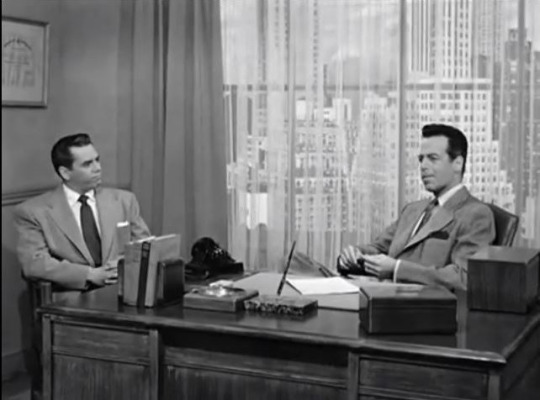
In “The Inferiority Complex” (ILL S2;E18) Ricky is worried about Lucy’s mental health and also consults a psychiatrist. Like George, Ricky brings him home to observe Lucy. So she doesn’t discover their plan, he calls himself Chuck Stewart, an old friend of Ricky’s.
Thinking that the psychiatrist is really the Hollywood director, Liz trots out the array of emotions and characters to impress him! First, a sexy Mae West voice:.
LIZ (ala Mae West): “Hello, boys. I’m certainly glad you came up to see me. There’s a sofa over there, Mr. Jones. Why don’t you get out of that hard chair and slip into something more comfortable?”
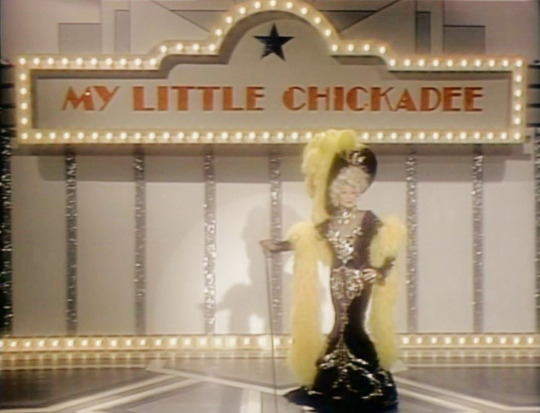
Mae West (1893-1980) was a stage and screen performer who capitalized on her sex appeal and was well-known for her scandalous sexual innuendo. In a 1977 episode of “Donny & Marie” (above) Lucille Ball did her Mae West impersonation yet again!
Liz immediately switches character to that of a desperate, scorned woman, wildly attacking George for his indiscretions:
LIZ (wildly): “You beat me with a cane and pushed my poor broken body down the stairs! I don’t care for myself, but you pushed the children after me!” GEORGE: “The children? I did not!” LIZ (flatly): “Then where are they?”
Liz leaves the room in crocodile tears and the doctor advises daily treatments. George opens the front door and it is Liz with a shawl on her head, talking like a bleating goat, begging for change.
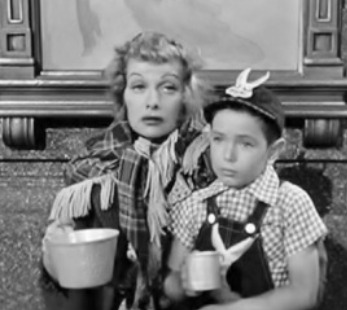
LIZ (bleating): “Will you buy a poor old lady’s violets? I haven’t eaten for a week.”
George rings for Katie, but Liz enters as a Cockney maid.
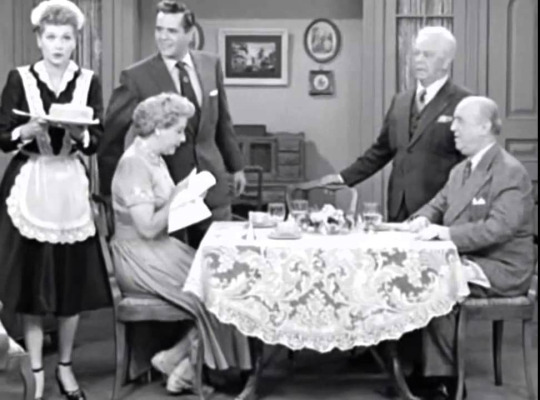
LIZ (Cockney): “Alright, alright! I’m comin’ guv’nor. Don’t get on about it!”
When George tells her to quit it, she drops to the floor to become a South seas Native girl!
LIZ (deep voice): “Me Tondelayo! Me love white man. You don’t love me?”
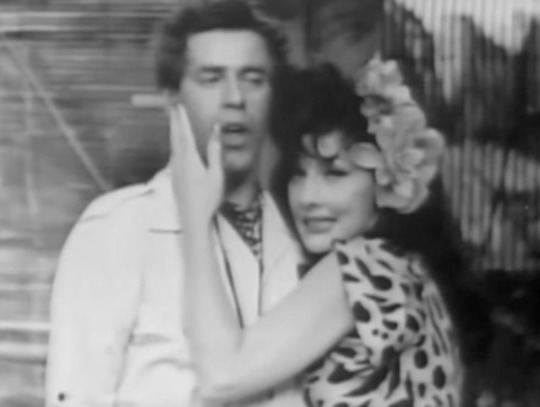
During a sketch in “Danny Thomas’ The Wonderful World of Burlesque” in 1966, Lucille Ball wears a leopard print dress and a black wig and struts in seductively saying “I am Tondelayo,” the same words and voice she uses here on “My Favorite Husband” in 1948, 18 years earlier.
As Liz is prostrate on the floor, the doorbell rings. It is Cory Cartwright, who has with him (as promised) a guest for dinner - Anatol Brodney! Liz faints.
Later, Mrs. Worthingill calls and George answers the phone. She tells George that Liz got the part, but George says Liz has given up the theatre for good. Just after George hangs up, Liz, who has been listening on the extension phone, tells Mrs. Worthingill to disregard what George said - she’ll be at rehearsals first thing in the morning! End of episode!
#My Favorite Husband#Lucille Ball#1948#Hans Conried#Ruth Perrott#Jean Vanderpyl#Elvia Allman#Richard Denning#John Loves Mary#Betty Grable#Lana Turner#i love lucy#Mae West#Xavier Cugat#Desi Arnaz#Vivian Vance#William Frawley#John Hiestand#Toni Home Permanent#Bob Lemond#radio
1 note
·
View note
Photo

Panther Girl of the Kongo
Panther Girl of the Kongo comes to us from Republic Serials, whose logo was mocked over and over every time it appeared in front of Radar Men from the Moon. It stars Phyllis Coates from Invasion USA and Myron Healey from The Unearthly and The Incredible Melting Man. It's also got giant lobsters for its monsters, and oh, yes, this is every bit as unbelievably silly as it was in Teenagers from Outer Space.
Our heroine is Jean Evans, wildlife photographer and vine-swinging Panther Girl! She and her crew are looking for a lion, but instead they find a giant crawdad that wrecks their camera! Understandably concerned (giant arthropods in the 50's were normally a sign of radiation), Jean calls up her friend Larry Sanders, a safari guide. Together they discover a truly diabolical plot: mad Scientist Dr. Morgan has discovered how to mutate arthropods into giants! What's he doing with them? Well, it just so happens that he's also found a hitherto unknown diamond mine, and is determined to scare the natives away[crustacean needed] so he can claim the land and have the gems all to himself.
There are thirteen episodes of this and almost all of them contain a furniture-smashing fistfight scene. I'm amazed they didn't run out of Jungle Hut props.

Let's get the technicalities out of the way first. Like Radar Men from the Moon, Panther Girl of the Kongo is designed around a series of cliffhangers – every episode must end with the hero and/or heroine in mortal peril so that the audience will come back next week to find out how they escaped. The answers are usually not exciting: at the end of Episode One (The Claw Monster!) Larry is knocked out by members of the evil Returi tribe while Jean is menaced by a crawdad. At the beginning of Episode Two (Jungle Ambush!) it turns out Larry was only momentarily stunned, fights off his attackers, and saves Jean in the nick of time. At the end of Episode Six (High Peril!), he appears to be about to fall onto spikes, but in Episode Seven (Double Trap!) we see that he actually lands well away from them. And so on.
The monster effects are... well, they're awful, but they're entertainingly awful. The crawdad attacking the miniature camera is pretty great, as is the one that's shown 'growing' by putting successively larger crawdads in a miniature cage! The giant puppet claws that reach out from behind rocks and trees to menace people are utterly hilarious – and of course we never see any blood on the 'injuries' these cause. And man, if you think the crawdads are stupid, wait until you see the movie's truly abominable gorilla suit. We saw better-looking shit in Season 11 Bigfoot movies!

There is a lot of stock footage here. Critic William Cline described the plot as functioning ‘to move the heroine from one piece of stock footage to another’. There's a sequence in which Jean promises some guests film of the strange creatures she's discovered, but adds that it's on the same reel as some of her other footage, which they'll have to wind through first. This is an excuse so that we can look at a bunch of documentary animal footage showing creatures like giraffes and cranes that definitely do not live in the jungle. There's a totally unnecessary recap episode. Jean's elephant friend Beela exists almost entirely in stock footage, and the same stock footage every time she appears (to be fair, this would have been way less noticeable in a weekly serial than it is watching the whole thing in a day). All the vine-swinging is from the earlier serial Jungle Girl, and is clearly a man in a dress and a wig! At least they matched the costume.
But we all know by now that what I love talking about in these pieces of antique media is their politics, so let's take a look at the political situation presented to us by Panther Girl of the Kongo.
We are shown two tribes, the Utanga who are Jean and Larry's hosts, and the Returi who work for Dr. Morgan. Do I need to specify that both are totally invented? No? Good. The prop and costume department gave these two peoples distinctly different looks, but these are designed less to suggest different cultures than to establish who are the 'good' and 'bad' Africans. The 'good' Utanga are a little Westernized. They wear textile clothing without much embellishment beyond Chief Danka's beads and feathered headdress, and live in houses with domestic animals such as chickens. The Returi, on the other hand, wear 'leopard skins' with body and face paint and jewelry made of bones and teeth, carry weapons everywhere, and seem to be a more nomadic hunter-gatherer tribe. The treatment is intended to dehumanize them, making them the obvious 'bad' guys.
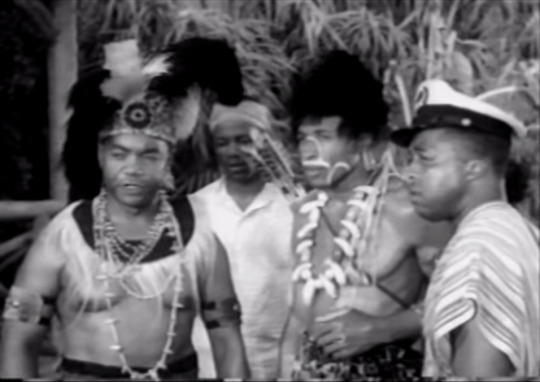
The two tribes seem to coexist peacefully. As in Voodoo Woman it's the white people who have brought trouble with them as they seek resources. Voodoo Woman hinged on Dr. Gerard's quest for power and Marylin's for gold, while Panther Girl of the Kongo concerns Dr. Morgan's interest in diamonds. The gems are quite useless to the local people who own the land, but very valuable to Morgan. He can't ask permission to mine the area because he doesn't want to have to pay taxes or fees on his finds, so instead he sets out to steal the land. In order for him to get the resources he needs, the natives must be either driven away or enslaved.
The monsters are intended to frighten off the Utanga. With the Returi, Dr. Morgan employs a different approach – he keeps them compliant by providing them with a 'tonic'. Exactly what this is, we're never told, but it's addictive and mind-altering, making those who take it more obedient and less concerned with their personal safety. I expected this to be a plot point somehow, but it's never returned to. It is reminiscent of a number of situations in real-life history: the fur traders would give the Native Americans alcohol in exchange for beaver pelts, and the British would sell the Chinese opium for tea. Now that they're under his thumb, Dr. Morgan can have the Returi do a great deal of his dirty work, while blaming the violence on the 'primitive tribe' who don't know any better. When one of the Returi men is shot and hurt, he is simply abandoned despite his friend insisting that he needs help. In Dr. Morgan's mind the natives are either tools or inconveniences.
There's a thread of the White Saviour trope in the story, too. While Dr. Morgan considers himself the master of the Returi, Jean and Larry seem to think of themselves as the protectors of the Utanga. Jean says that with the monsters running loose in the jungle, the men of the village would rather stay home to protect their families than go out and hunt the creatures down, so the latter job is left to the white people. Indeed, Morgan's men are counting on this – they believe the Utanga will depart at once if Jean and Larry are killed and therefore no longer able to protect them. Later the Utanga actually do flee en masse, and the white people have to promise protection to make them come back. The government and police force who will solve the problem if Jean can only find proof against Dr. Morgan are also white – history would suggest that they're Belgians, but they speak with British accents. I guess the writers didn't research anything else, why would they bother to get that right?
In this case, I really don't think any of this is social commentary. It's much more superficial than it was in Voodoo Woman, and I get the idea that it was written this way because somebody just figured that was how things worked in Africa.
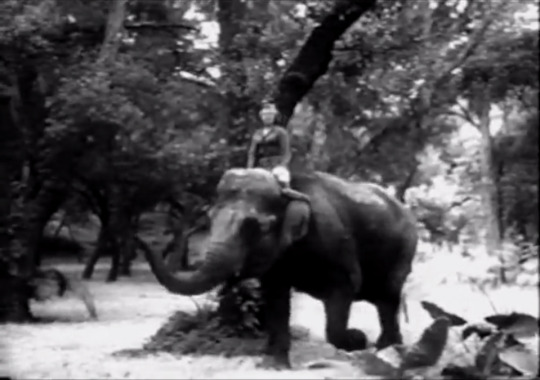
Another thing I find kind of interesting about the series is how, despite the jungle and savannah setting, Panther Girl of the Kongo often feels like a western. This may be mainly on account of the 'mining' plot – trade diamonds for gold or silver, give the two tribes faux-Native-American names instead of faux-African ones, and shift us from the jungle to the desert, and the whole 'chase the locals away from the undiscovered mining site' plot would work equally well. When we see a larger settlement than the Utanga village, many of the sets have a very 'wild west' feel to them, possibly even being hastily-redressed leftovers from a western movie. There are certainly plenty of shootouts and barfights that would be right at home in a cowboy movie, and probably contribute to the 'western' atmosphere. Such a story could even keep up Jean's friend-to-animals persona, having her hang out with bears and feral horses instead of lions and elephants. 'Coyote Girl of Nevada'? Why not?
The ease with which this could be done speaks to something else: the formulaic nature of the story. It's made of tropes, pieced together into a plot that would use (as Cline noted) as much of their stock footage as they could. The only reason it's a jungle story rather than a cowboy story was because they happened to have the jungle footage on hand. If they'd had stuff left over from Radar Men from the Moon instead of Jungle Girl, it might well have been a space story instead ('Rocket Girl from Venus'?). Panther Girl of the Kongo was the sixty-fifth serial Republic had produced, and like Disney with its princesses, they pretty much had their formula down.
But that's not necessarily a bad thing. If you just sit and watch it, Panther Girl of the Kongo keeps the animal footage and jungle peril coming steadily enough to keep you from getting bored, and the story is reasonably engaging. The monsters and gorilla suits aren't believable for a minute, but they're amusing, and the bite-sized serial format means you can watch a couple, get tired of it, and come back to it later, when the title cards will kindly remind you which heart-stopping cliffhanger you left off on. Each episode has a mini-plot that contributes to the overall narrative while also feeling acceptably self-contained, and Jean is a fairly capable heroine, saving Larry's life almost as often as he saves hers.
It’s not art. Indeed, it’s clearly a sort of assembly-line product, but I can see how this stuff made money.
#mst3k#reviews#episodes that never were#panther girl of the kongo#guys in gorilla suits#boy are we in africa!#50s#giant arthropod hours
11 notes
·
View notes